THE COMPELLING STORY OF ITALY’S SECRET SURRENDER DURING WORLD WAR II
Archival visits are a lot like treasure hunts. Filled with the prospect of documentary riches, most researchers—like treasure hunters—know there is no promise that long hours of investigation will yield rewarding discoveries. Still, the possibility of unearthing the occasional gem is often too enticing to resist; it is the same hope that motivates the historian’s visit to the archives, the long days wading through homogenous archival boxes, and the unending flipping of musty, timeworn pages.
by Carson Teuscher
Uncovered almost anywhere else, everyday objects housed in the world’s archival repositories would likely be dismissed as antique at best—old and uninteresting at worst. And yet, an artifact’s mere presence in an archive can lend it value that otherwise might go unnoticed. Take, as one example, an innocuous cardstock folder labeled “SECRET” in bold, black letters.
Last September during our first ever visit to the George C. Marshall Research Library, my father and I came across this artifact in box 1,
5
STORIES FROM THE ARCHIVES Opposite: Archives at the George C. Marshall Foundation
Envelope inscribed by Carter Burgess (VMI ‘39)

folder 23 of the Carter Burgess collection. At first glance, the folder is plain and uninteresting. Empty, lightly scuffed in places, and bearing several blemishes, on its own it offers no insight into where it came from—nor what it once carried.
Adjacent artifacts offer clues to the folder’s significance. Accompanying the secret folder is an Italian ten-lire note inscribed with the date “9/28/43” and Mr. Burgess’s initials; a Maltese two-shilling noted bearing the date “9/29/43,” and an envelope emblazoned with a golden eagle crest of the United States. In blue cursive ink, Burgess’s own handwriting offers another glimpse into the folder’s past.
“Circa September 1943, MALTA. Note: The full story of this classified folder is in an envelope on the back of this frame. Briefly, the First Italian Surrender was signed in this folder aboard a British Man-of-War in Valetta Harbor, Malta. I was there! Carter L. Burgess.”
If this folder could talk, what stories would it tell?
Born on Christmas Eve, 1916, in Roanoke,
Virginia, Carter Burgess graduated from the Virginia Military Institute on the eve of World War II in 1939. Marrying his sweetheart a month before Pearl Harbor, he entered the military as a second lieutenant, rising to the rank of colonel by war’s end. His assignments took him across the Atlantic to Europe. There, he served as a staff officer and secretary to the general staff at General Dwight D. Eisenhower’s Allied headquarters (AFHQ)—first in the Mediterranean Theatre, then in Europe.
Burgess’s proximity to Eisenhower, and his role as one of the favorite aides of Ike’s chief of staff, General Walter Bedell Smith, likely played a role in his possession of this secret folder. While its exact provenance remains unknown, the saga that preconditioned its wartime use at Malta “reads like the most improbable fiction.”
CONTEXT
By late summer 1943, Allied forces in the Mediterranean delivered a major blow to the Axis, liberating Sicily on August 17. The campaign
6
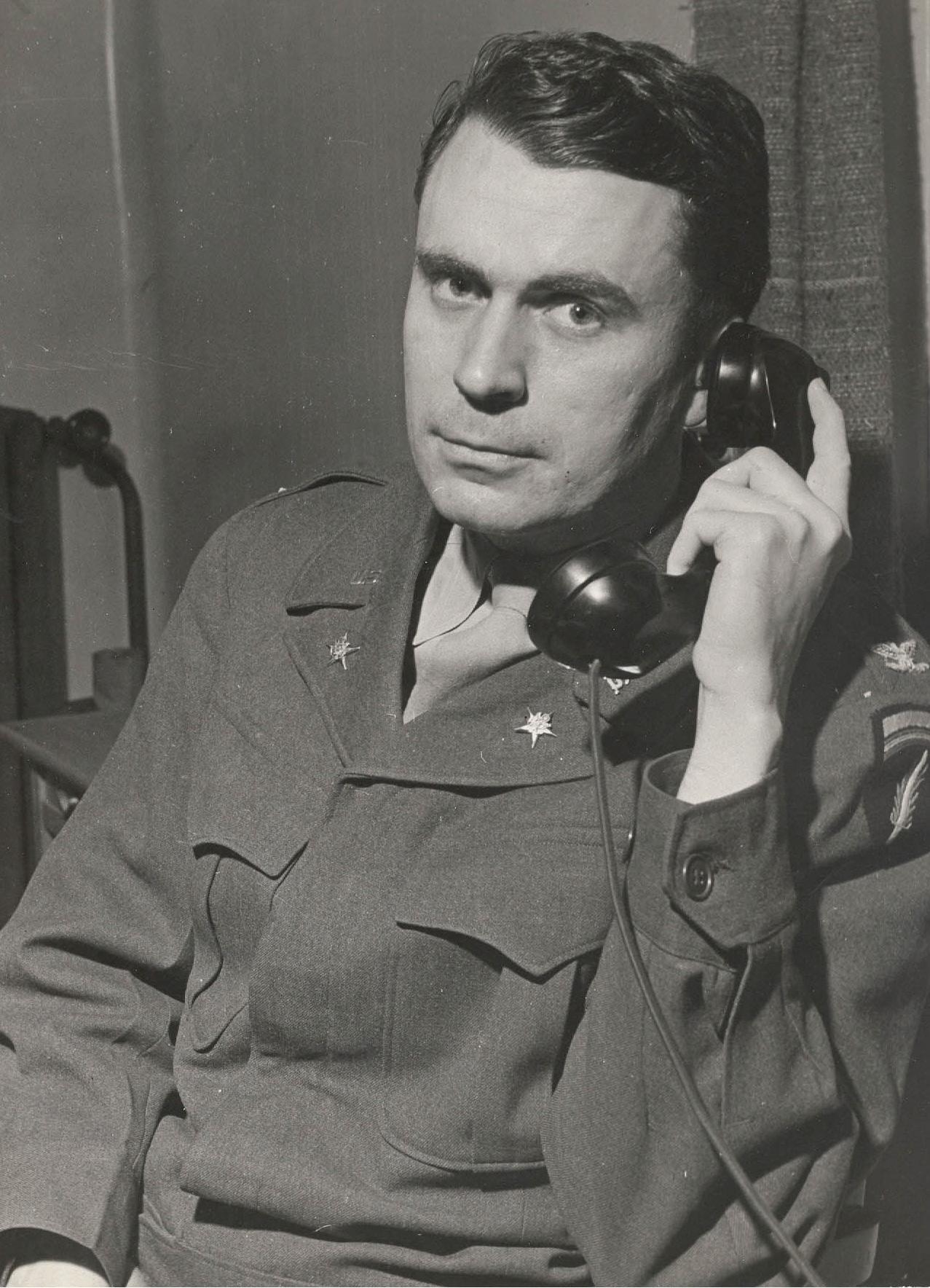
augured poorly for the Italian high command; aware the next invasion would likely come on the Italian mainland, many sensed the strategic initiative firmly shifting to the Allies’ favor. Prior to the campaign, popular support for Italy’s fascist dictator, Benito Mussolini, reached an alltime low. Pushed to the periphery of the German agenda while Germany embarked on Hitler’s selfish crusade for lebensraum, Mussolini himself knew Italy had become little more than a junior partner in an already asymmetrical alliance. Now incapable of defending their own territory, Italian leaders recognized further collaboration with Nazi Germany portended Italy’s ruin. There was only one recourse.
While the battle for Sicily raged, a small cohort of Italian military officials laid plans to depose Il Duce. At 3:30 a.m. on Sunday, July 24, 1943, Italy’s Fascist Grand Council held its final meeting in Rome’s Palazzo Venezia. Voting 24-7 to remove their leader from his post, soldiers arrested Mussolini as he departed the palace. In his stead, Italian officials appointed Marshal Pietro

Badoglio as head of the Italian government—a man who, having only heard about the conspiracy the day before, nevertheless pledged to steer Italy into the Allied orbit.
It would not be easy. As the attack on Sicily intensified and mainland Italy increasingly felt the destruction of Allied bombs, vigilant Nazi officials tightened security throughout Italy, installing Gestapo agents throughout Rome and guards on every road of departure. It took fourteen days for Badoglio to successfully dispatch an envoy through the German security blanket; that he did manifested his willingness to negotiate Italy’s surrender and join the Allied cause.
PORTUGUESE PARLEY: SECRET ENCOUNTER IN LISBON
Traveling as part of a diplomatic delegation sent to Lisbon to welcome Italy’s ambassador to Chile on his return to Europe, two Italians bore the “difficult and dangerous mission of contacting the Allied nations and arranging to get Italy out of the war.” The first was thirty-six-year-old
7
Left: Carter Burgess Right: Marshal Pietro Badoglio
Franco Montanari, the Harvard-educated son of an American mother who lived with his siblings in Vermont. Montanari spoke perfect English, previously serving as the Italian consul in Honolulu. He would act as an interpreter and political advisor to his military companion, General Giuseppe Castellano, an officer of Sicilian descent who rose to prominence on the staff of General Vittorio Ambrosio, a known Allied sympathizer and chief of staff of the Italian armed forces.
Dressed as civilians, Castellano and Montanari departed the diplomatic train in Madrid under the pretext of visiting friends. The pair immediately informed the British ambassador to Spain of Badoglio’s desire to negotiate with the Allies. The unexpected announcement prompted a barrage of Allied planning; verifying their credentials, Allied officials told both Italians to wait in Lisbon until Eisenhower could rush delegates to meet them.
Eisenhower chose his trusted lieutenant and chief of staff Major General Walter Bedell Smith for the task. A stern, square-jawed career staff officer referred to as Ike’s “hatchet man,” Smith was accompanied by Brigadier K. W. D. Strong, a bright British intelligence officer and assistant chief of staff, G-2 at AFHQ. Both were chosen because of their familiarity with the latest plans

to invade mainland Italy. Strong’s knowledge of the Italian language and culture also helped.
Smith and Strong departed Algiers for Gibraltar on the afternoon of Wednesday, August 18, 1943, dressed like their Italian peers in civilian clothes. Each assumed false identities and bore false passports—Smith posing as a businessman, Strong a commercial traveler. Boarding a passenger liner the next day, one-and-a-half hours later the unarmed envoys touched down in Lisbon.
To their relief, neither were recognized by Portuguese customs officers. Traveling in an undercover vehicle, they soon arrived at the home of one George F. Kennan, the American charge d’affaires in Lisbon—a man who within a few years would become famous himself as the founding father of America’s containment strategy during the Cold War.
Smith and Strong waited in Kennan’s home until nightfall. At 10:30 p.m., the two proceeded to the private residence of the British ambassador, Sir Ronald Hugh Campbell, to await their Italian negotiators. With Gestapo agents prowling the city, the Italians went to meet them. Smith and Strong took every precaution to preserve their anonymity. After dinner in their hotel, the pair took a taxi to another restaurant for coffee before hiring a second taxi to the outskirts of the city.


8
Left: Major General Walter Bedell Smith
Center: Brigadier General K. W. D. Strong, OBE
Right: George F. Kennan
There, they entered a building and left through the back door—a move calculated to evade unwanted company. They could not be too safe. A third taxi deposited them at the ambassador’s residence, where they were ushered into a dim study, shutters closed, curtains drawn.
The delegations introduced themselves formally. There were no handshakes. The Americans made a point of ensuring the Italians were, in fact, Badoglio’s accredited representatives by getting in touch with a British minister at the Vatican. He confirmed their diplomatic status.
As the senior spokesman, Smith delivered the Allied terms: Italy and its armed forces would surrender unconditionally. It would recall its overseas forces immediately, and it would turn over all military bases for Allied use. The Italians,
thereafter, would assist the Allies as far as possible. Political and economic terms would be negotiated later. Hoping to avoid the ignominy of surrender, Castellano hoped Italy could join the Allied cause without formally admitting defeat. Smith held firm—sign the armistice, or no deal.
Following Smith’s opener, Strong took over. The conversation touched on Axis troop dispositions in Italy, the feasibility of establishing communications between Algiers and Badoglio’s government in Rome, how to secure the Italian fleet, and Mussolini’s fate. The Italians provided plenty of valuable intelligence for Allied planners. Aides in an adjacent room lent their insight and worked on the specifics of the armistice through the night.
The Italians bade farewell to their Allied coun-
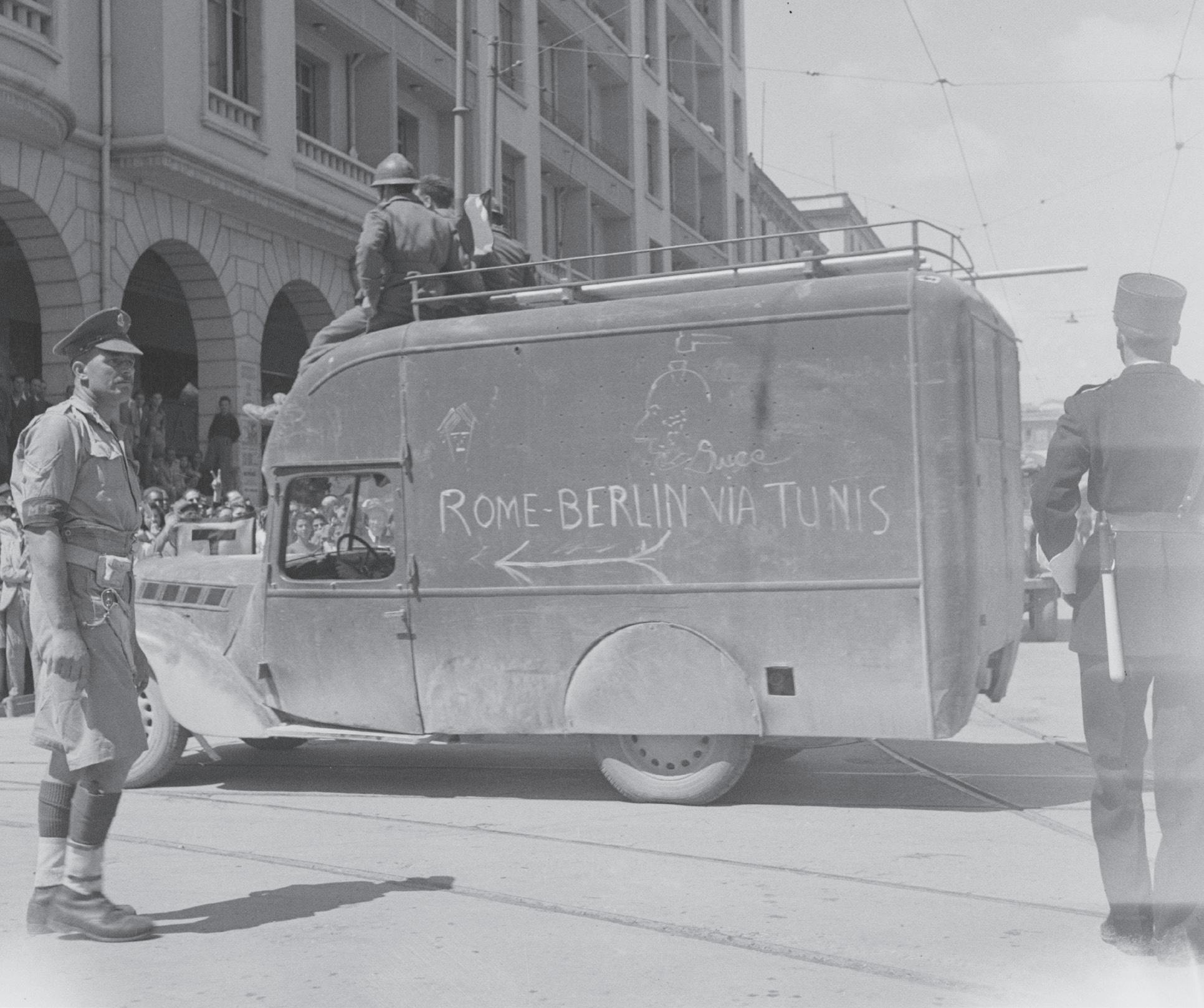
9
Allied vehicle in Tunis, 1943
terparts as the twinkle of dawn illuminated Lisbon’s eastern horizon. Given a briefcase bearing a specially disguised portable radio capable of relaying messages between Rome and Algiers, Montanari carried the actual terms in his inside suit pocket. Reuniting with their Italian diplomatic cadre, the two traveled back to Rome through southern France aboard a special Italian train. For their part, Smith and Strong returned to Algiers wondering whether their counterparts would make it back safely. The wait was on.
AN UNEXPECTED INTERMEDIARY
Several nervous days passed while the Allies awaited Badoglio’s response. In the interim, a “sensational new development . . . threw the Allied camp into a welter of doubt and suspicion.”
Italian Brigadier General Giacomo Zanussi, senior officer on the staff of the Italian Army chief of staff, had surfaced in Lisbon, telling an Allied contact he was eager to discuss the terms of Italy’s surrender on Badoglio’s behalf.
Zanussi’s sudden appearance—accompanied by a British general captured by the Italian armed forces in 1941 whom he brought along to bolster his credentials—raised eyebrows at AFHQ. The Allies soon discovered that Badoglio, unaware of
delays imposed by the late arrival of the Chilean ambassador on Castellano and Montanari—and worried Italy itself might soon be invaded—sent Zanussi on a last-ditch mission to reach an agreement with the Allies. Little did he know, Montanari and Castellano would soon arrive in Rome bearing the Allied terms.
Forced to relinquish his British captive, Zanussi reiterated Badoglio’s concerns to Allied personnel in Lisbon. He hoped contacts at the Vatican could vouch for him. Intelligence officers in Algiers called attention to the fact that Zanussi’s long-time superior, General Mario Roatta, had been military attaché in Berlin for four years and “was considered of all Italian army officers to be the closest and most sympathetic to the Germans.” He could, ostensibly, also represent a hostile faction in Italy—one opposed to the Badoglio government. It was almost impossible to know for sure.
Seeking clarity, AFHQ sequestered Zanussi in Algiers to interview him in person. After twenty-four hours of “almost insupportable tension,” on Friday, August 27, the Allies finally established contact with Badoglio in Rome. Badoglio informed Zanussi of the arrival of Castellano, Montanari, and of the Allied terms. Zanussi ur-

10
Map of Sicily with Cassibile marked by red arrow

gently exhorted his superior to accept the armistice terms, whereafter he “faded completely out of the negotiations picture” just as rapidly as he had appeared.
ANOTHER RENDEZVOUS
Five days later, Badoglio relayed his desire to comply with the Allied terms. On August 31, Castellano arranged a meeting in Sicily to finalize the negotiations. Taking off from Rome in a plane headed toward Sardinia, the pilots diverted for Sicily, where Allied Air Forces, warned of their arrival, greeted them at the Termini airfield.
Strong greeted Castellano on the tarmac and ushered him into a khaki-colored limousine. Driving ten minutes down the Sicilian coastline, they arrived at AFHQ’s Advanced Headquarters outside Cassibile, just southwest of Syracuse.
There, Castellano met with Smith, Zanussi, and several Allied negotiators who had arrived from Algiers.
Congregating in a series of tents assembled in the shade of an olive grove, armistice talks began promptly at 11 o’clock. Castellano started the discussion with a grave announcement; since the Lisbon encounter, the situation in Italy had changed. Sensing Italian treachery after the fall of Sicily, German troops were pouring into the Italian peninsula to prepare for what they viewed as an imminent Allied invasion. The Italians knew Nazi Germany could be ruthless. Badoglio’s government, Castellano explained, as well as the people it represented, naturally feared German reprisal.
Reading from a prepared statement, Castellano elaborated that Badoglio sought to delay the sign-
11
(Left to right)
K. W. D. Strong, Giuseppe Castellano, Walter Bedell Smith and Franco Montanari in Cassibile.


ing of the armistice until the Allies could guarantee protection against Germany. At the very least, a delay might allow Italy to defend itself against German forces before the occupation grew out of hand. Smith and Strong, however, knew plans for the amphibious landings at Salerno were well in the works. The invasion of southern Italy, mere days away, would happen whether the Italians cooperated or not.
Each reminded Castellano the Allies would not negotiate on a conditional basis. Their plans were firm; the Italians could join and help liberate their homeland, or wait and suffer the consequences. Aware Castellano spoke more English than he let on, Allied negotiators played up the combined Allied fighting strength—“a gigantic bluff,” noted one reporter. It did not matter. Both Smith and Strong knew knocking Italy out of the war diplomatically was preferable to doing it by force.
That evening, the Italians returned to Rome.
Irritated by Italy’s indecisiveness, the Allied negotiators imposed a firm deadline on the Italians to provide an unambiguous answer by end of the following day. Predictably, however, the Italians delayed. Nineteen hours late, word arrived at AFHQ that the Italians had accepted the armistice. Castellano scheduled his return to Sicily to finalize the deal.
THIRD TIME’S THE CHARM
One final hurdle delayed the secret signing of the Italian armistice. Meeting back in the olive grove outside Cassible, Castellano vacillated once more. In a calm voice, he informed his peers that while the government accepted the terms, he was not authorized to sign on Badoglio’s behalf.
The announcement infuriated the Allies, who told Castellano unless he signed then and there, the negotiations would collapse. Flashing a cable beseeching the Italian government to deposit a Previous: Signing of the armistice.
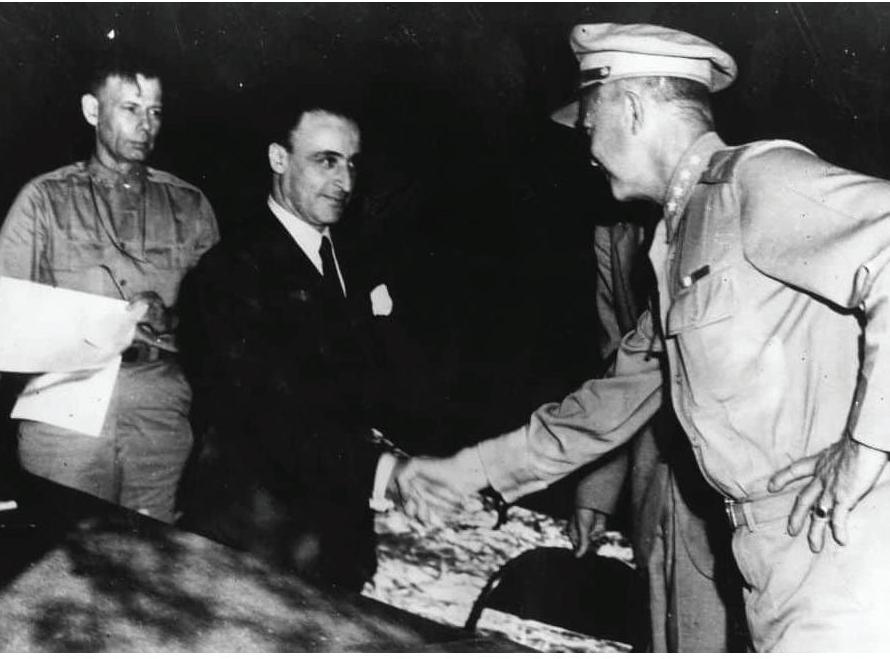
14
Alamy photo.
Left: Castellano and Eisenhower shake hands following the signing of the
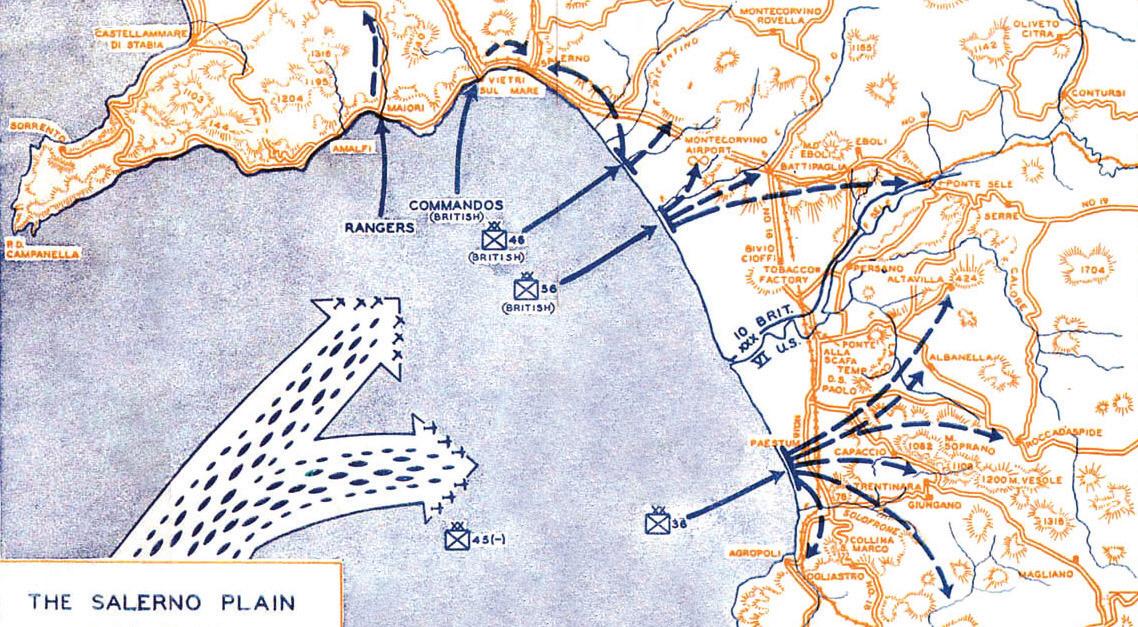
written statement at the British ambassador’s Vatican office authorizing Castellano to sign, strained radio operators grew incensed as atmospheric effects hampered transmission to Rome. While the negotiators anxiously waited for a response, General Eisenhower arrived and joined the party.
Finally, several hours later, a relieved wireless operator informed Eisenhower that Badoglio had indeed submitted the requisite paperwork authorizing Castellano to sign the armistice. Filing back into the dusty tent for what they hoped was the last time, sunlight poured through the trees, casting shadows on the table bearing the Allied terms of surrender.
Castellano, pulling a pen from his double-breasted suit pocket, signed with an energetic flourish, flanked by Montanari and Smith, who expressed their approval. Smith, using his own fountain pen, went next.
The momentous signing—one that likely saved tens of thousands of lives in the coming campaign through the Italian peninsula—played out to little fanfare. Sharing a drink of whiskey, the participants shuffled out of the tent. Smith and Castellano plucked branches from nearby olive
trees—an appropriate symbolic gesture. Eisenhower shook Castellano’s hand and quickly departed.
THE CANCELED AIRBORNE GAMBIT
With Italy’s fate now intertwined with the Allies, leaders at AFHQ wondered how to announce the armistice terms. Within a few days, British forces would land on Italy’s toe; several days after that, the U.S. Fifth Army would slam into the Salerno coastline, south of Naples. Feeling it would be best to share news of the armistice on the eve of the Salerno landings—both to forestall German countermeasures and ensure the Italians had sufficient time to react— Eisenhower and Badoglio agreed to simultaneously broadcast the terms at 6:30 p.m. on the evening of September 8, 1943.
Now becoming a variation on a common theme, new developments threw Allied planners into a frenzy. With Allied amphibious forces in their final stages of preparation, on September 5 Castellano transmitted Badoglio’s request that American airborne units be dropped around Rome in a bid to seize of the Eternal City. They would, he promised, receive assistance from Ital-
Allied plan for the Salerno landing, September 9, 1943.
15
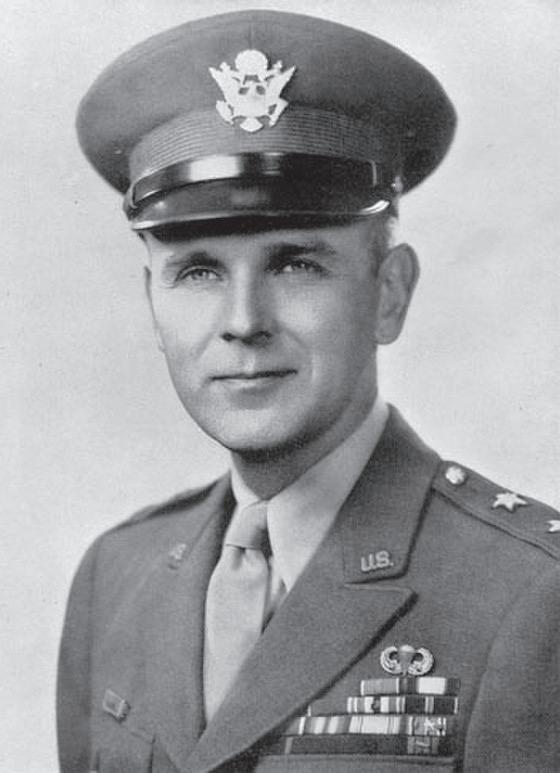
ian troops in the vicinity. Castellano knew little of the Allied invasion, nor did he know American paratroopers were already earmarked for an operation near the Volturno River north of Naples. However, the prospect of capturing Italy’s capital was too enticing to ignore.
After a long night of deliberation, Allied leaders agreed to scrap the Volturno River drop. Left with just two days to prepare an operation that under normal conditions might require three to four weeks’ planning, the Allies needed assurances Italian soldiers would assist the paratroopers regardless of Germany’s response. For that, they needed someone to confer with Badoglio himself.
To scope out the operation’s chance of success, Brigadier General Maxwell Taylor, second-in-command of all American airborne divisions, and Colonel William Tudor Gardiner of the U.S. Army Air Forces were selected for an eleventh-hour mission to Rome. Handsome, tan, slim, and perceptive, the forty-two-year-old Taylor “personified the corps d’élite that comprises the parachute divisions of the U.S. Army.” Harvard
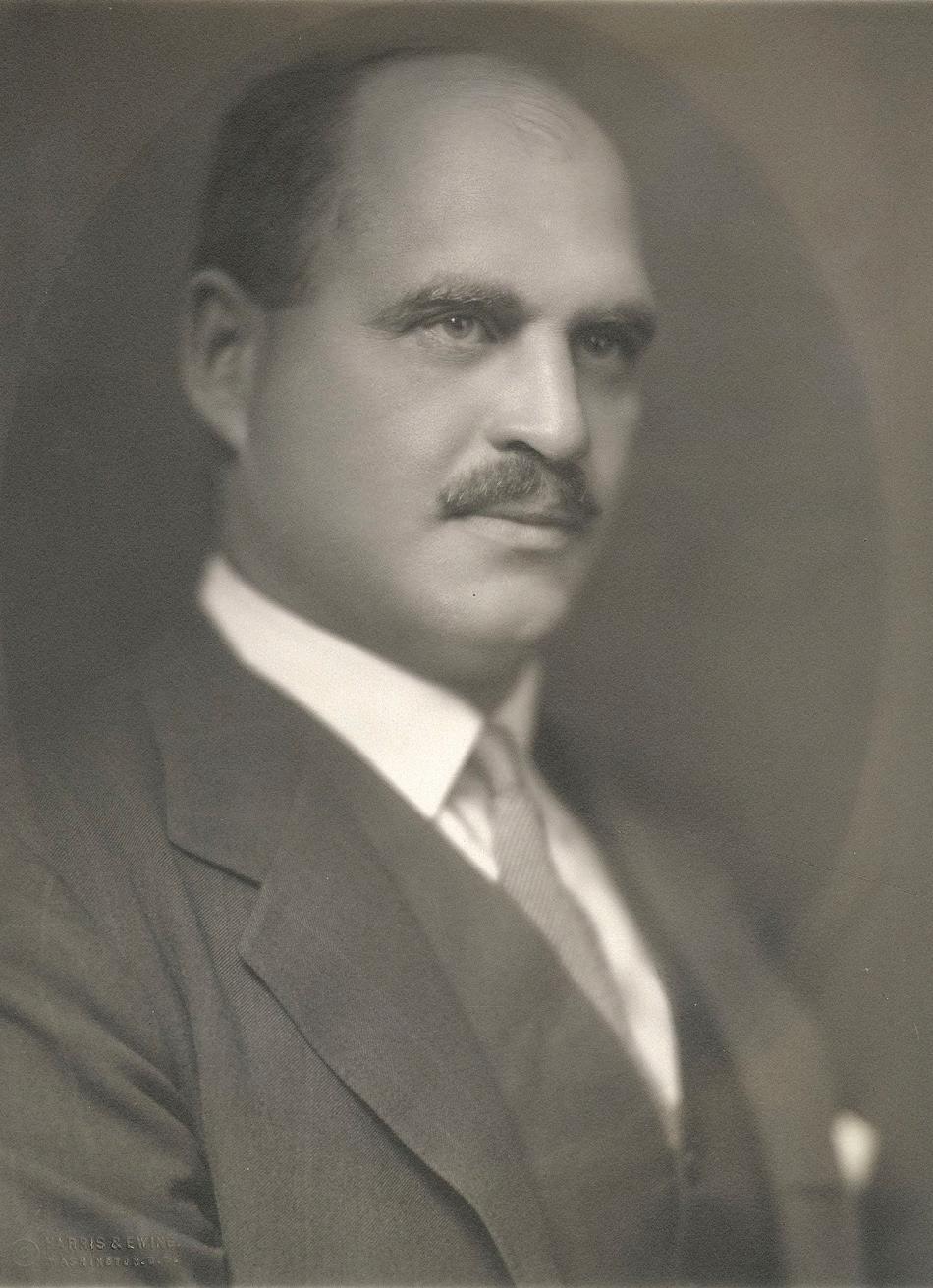
educated and ten years Taylor’s senior, Gardiner possessed equally encouraging credentials. A World War I veteran, after the conflict he had became a lawyer, later serving two terms as governor of Maine.
The heightened need for operational secrecy imposed temporal constraints on their mission. Their superior, British General Harold Alexander, informed them they could not go unless it was twenty-four hours before the paratroop operation on Rome. If captured, the Allies risked losing the element of surprise in their upcoming amphibious landings—an outcome that could result in the loss of an entire airborne division. Sobering prospects indeed.
The duo left Cassibile on the morning of September 6, 1943, with plenty of travel ahead of them. Staying overnight in Palermo, Italian agents made arrangements to receive the Americans in Rome over their suitcase-set radio. Wearing tan military uniforms and sidearms to lend legitimacy to their mission—and render them safe from the ignominious fate befalling most captured
16
Left: Maxwell Taylor, 1945
Right: Portrait of William Tudor Gardinier, governor of Maine

spies—in the early morning of September 7 the Americans clambered into a British PT boat that took them to Ustica, an island forty miles off the coast of northwestern Sicily.
There, they transferred onto an Italian corvette piloted by Admiral Francesco Maugeri of the Italian Office of Naval Intelligence. He provided plenty of food and wine to maximize the American’s comfort on the pleasant, two-hundred-mile voyage up the Italian coast. To avoid suspicion, they planned to pose as captured aviators whose aircraft had gone down in the Mediterranean. An Italian guard privy to their plans would escort them to Badoglio himself.
Landing at the naval docks at Gaeta, seventy-five miles south of Rome at 6:30 p.m., Italian soldiers stuffed the ruffled operatives into an automobile and sped away, while Italian sailors in the navy yard watched with interest. The party drove without stopping to the outskirts of Gaeta, where a small delivery vehicle, engine purring idly, awaited them. Merging onto the Appian Way, Taylor and Gardiner observed several road-
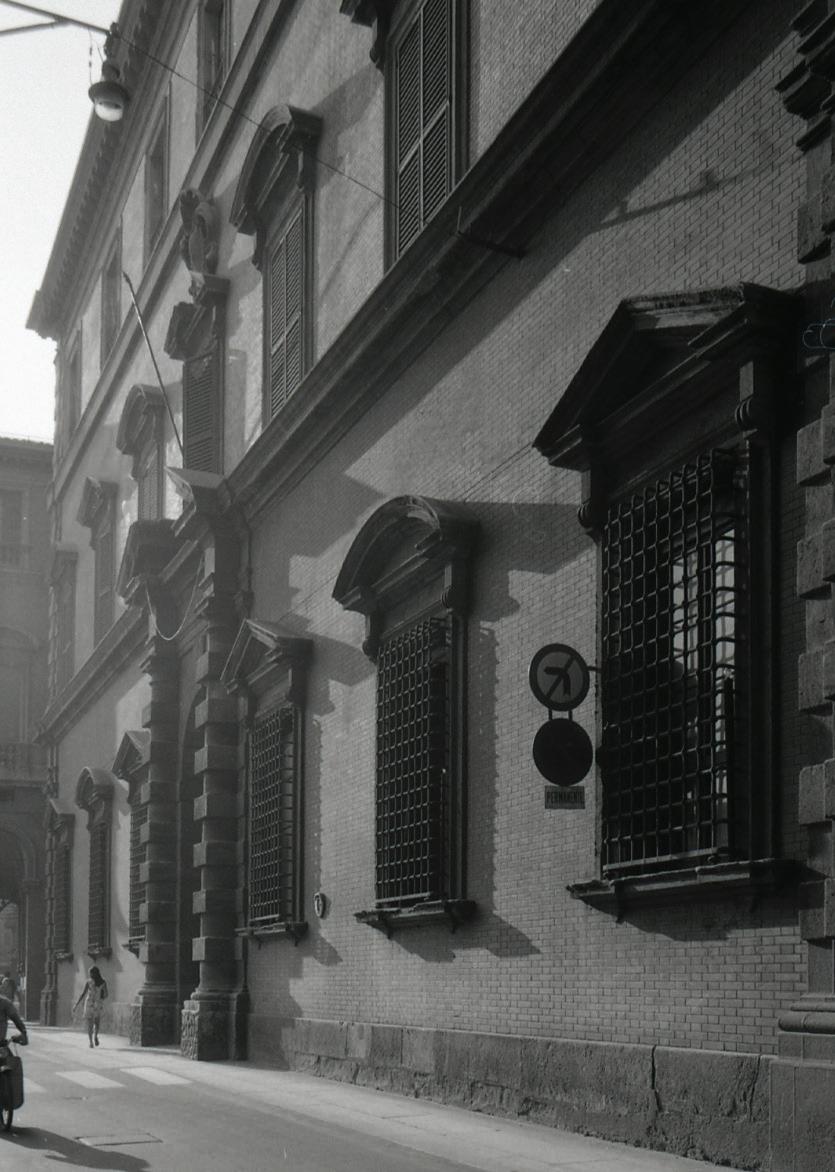
blocks but few German soldiers on the road to Rome.
They arrived after nightfall, meandering through Rome’s streets to the Palazzo Caprara, a building adjacent to the Italian War Office and crawling with sentries. There they waited in ornate bedrooms situated in a secure wing of the palace—an undeniable upgrade to the spartan battlefield accommodation to which they had grown accustomed. Greeted by the chief of staff to General Giacomo Carboni, commander of Italian troops in the Rome area, the Americans were soon feted at a luxurious feast by Italian officers oblivious to the imminent Salerno landings.
Wiling away the precious hours with toasts and invitations to converse deep into the night, the frustrated Americans grew worried they might overstay their welcome. In less than twenty-four hours, the world would know of the armistice; shortly thereafter, Allied troops would disembark at Salerno. Their airborne operation, scheduled six hours ahead of the amphibious landings, were now just over a day away. They desperately need-
17
Left: General Giacomo Carboni, 1940
Right: Later photo of Palazzo Caprara, Rome
German tanks in Milan, September 1943
ed to speak to Carboni and Badoglio.
After conveying their apprehension, Carboni arrived to greet the Americans. The two asked for his impression of the prospective operation, andhe expressed serious reservations. More German troops arrived by the day. News of the armistice would undoubtedly result in Rome’s immediate and urgent occupation. The Germans would, in turn, seize and reinforce its neighboring airfields. They controlled all fuel, supplies, and ammunition in the region. Consequently, Carboni noted, his forces could only fight for a few hours—at most. An airborne landing made in such conditions would be nothing less than a suicide mission. Worse still, Carboni begged the Americans to delay the armistice announcement, if only to forestall the establishment of another Fascist government in Rome.
Discouraged by Carboni’s appraisal, the Americans convinced their hosts to grant them an audience with Marshal Badoglio. Winding down Rome’s dark streets to Carboni’s limousine, jumpy
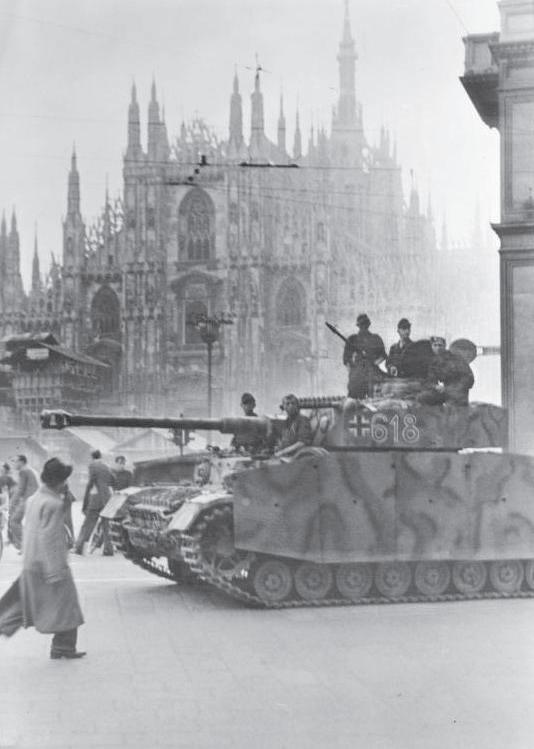
sentries stopped the group eight times during the subsequent twenty-minute drive to Badoglio’s villa. Air raid sirens wailed in the distance, and angst permeated the vehicle as it pulled up just after midnight. The fate of an entire airborne division—and perhaps the armistice itself—hinged on Badoglio’s word.
The Americans found the marshal awake, in his pajamas, surrounded by aides scurrying about the villa’s well-lit foyer. Ushered through ornamented marble halls to an upper-level study, Taylor, unable to speak Italian, addressed the marshal in French—a language Badoglio partially understood. Gardiner took notes on “what turned out to be a very tense, short interview.” Summarizing Carboni’s dour prediction, Taylor found the marshal in agreement. “If I announce [the armistice] tomorrow night,” he worried, “the Germans will cut my throat the following morning.”
Taylor, aware he was now acting in a diplomatic role far beyond his military rank, reminded the marshal of his obligations to uphold his end of the armistice. After Taylor enumerated the consequences of reneging on his word, an emotional Badoglio shot back. He did not believe the Allies would punish the Italians for wanting to wait for the right moment to cast their lot against the Axis. They only wanted to keep their people safe, after all.
Taylor countered. Italy was already under dual occupation, he argued—the Germans in the north, and now the British advancing up the toe in the south. Allied bombings would intensify the longer Italy remained an active belligerent. Soon the Americans would arrive in force. There was no time for delay; the marshal had the power to save thousands of lives. This armistice would almost certainly pave the way for Italy’s liberation. However, Badoglio held firm in the face of this argument.
Taylor encouraged Badoglio to draft a message to Eisenhower outlining his position. Taylor, meanwhile, composed a message of his own, urging Allied officials to postpone the Rome air-
18
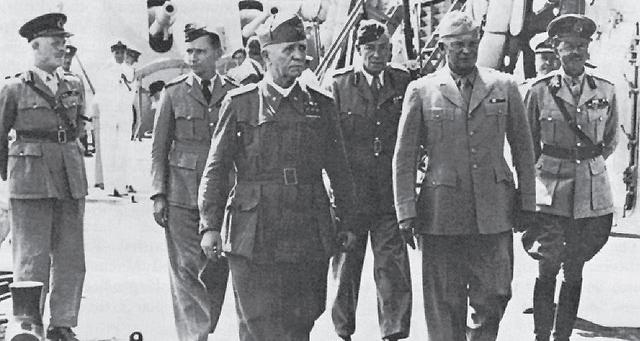
borne operation. At the close of their meeting, Badoglio clasped Taylor’s hand in his own and, looking him in the eyes, pledged “by my honor of fifty-five years as a soldier my loyalty to the Allied cause.”
Atmospheric interference once again delayed the delivery of Taylor’s critical message. Dispatched at 1:21 a.m., it arrived more than four hours later on the morning of September 8. Allied leaders at AFHQ received it on their desks several hours after that. Having already foreseen the possibility of a botched airborne operation, AFHQ forwarded a codeword indicating its immediate cancellation: “Innocuous.” Taylor waited for hours for confirmation that the operation had been canceled. Sleeping fitfully and waiting through the night as the sound of American bombers roared overhead, General Carboni finally informed Taylor and Gardiner, much to their relief, that their messages had been received at 11:35 a.m. and the Rome mission aborted.
By 3:30 p.m. plans had been arranged to smuggle the Americans out of Rome aboard an outgoing transport plane. With the armistice declaration just three hours away, on his way out Taylor reminded Badoglio of the consequences if he failed to live up to his word as a soldier. Taking an
undercover vehicle out along the same route they had taken into Rome, the group boarded an Italian bomber parked on the runway and took off.
The mission was an unequivocal success, but only just. By the time Taylor’s message had filtered down the Allied chains of command, “the paratroops were already on the field, set for takeoff.” That evening, Badoglio delivered on his word—albeit, predictably, an hour and a half late. Announcing the armistice on Radio Rome at 8:00 p.m., he fled the city early on September 9 alongside Italy’s King Victor Emmanuel III, finding refuge among the British forces at the port of Taranto.
FINALIZING THE ARMISTICE: THE ITALIAN FLEET AND THE SECRET FOLDER
These unbelievable scenes preceded the armistice’s final act: the surrender of Italy’s powerful navy of more than two hundred vessels in the aftermath of the September 8 radio announcement. Allied leaders worried that in the chaos to follow, Italian naval officers might be encouraged to resist the Allied landings, scuttle their ships, or turn them over to the Germans. To avoid this outcome, they worked a clause into the truce
19
Badoglio, Eisenhower and other officials meet aboard the HMS Nelson to ratify the armistice.

calling for all Italian naval personnel to sail for Allied ports after the announcement—those on Italy’s west coast were directed to North Africa, and those at Taranto, to Malta.
Most Italian admirals knew nothing of Badoglio’s armistice until his broadcast on September 8, 1943. Luckily, the Italian admiralty complied with the terms, setting sail “after a near mutiny” on September 9. The next day, the first Italian vessels laid anchor off the Maltese coast under British escort. More warships and submarines arrived over the ensuing month, each pledging to collaborate with the Royal Navy and bolster Allied naval power in the Mediterranean.
On September 29, 1943, the Allies held a formal ceremony on the deck of the British battleship HMS Nelson, anchored in Malta’s Valetta harbor. The meeting would publicly ratify the complete terms of the Italian armistice, negotiated and signed in secret several weeks earlier. On the deck, Field Marshal Pietro Badoglio, dressed in his Italian uniform and cap, conferred with General Eisenhower and other Allied leaders.
Among them, porting the detailed armistice terms they would sign in an innocuous cardstock folder labeled “SECRET” in bold, black letters, was Carter L. Burgess.
Oh, if that folder could talk, what stories would it tell?
Carson Teuscher is a PhD candidate specializing in military history at Ohio State University. His dissertation assesses the Allied coalition in the Mediterranean during World War II. A native of the Pacific Northwest, Teuscher received his BA in history from Brigham Young University in 2016 and an MSt in U.S. History from the University of Oxford in 2017.
20
Carter L. Burgess receives Legion of Merit award from Dwight D. Eisenhower
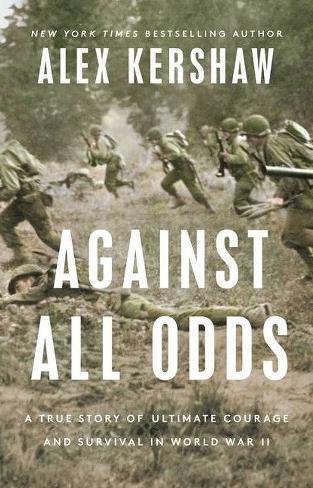
AGAINST ALL ODDS: A True Story of Ultimate Courage and Survival in World War II
by Alex Kershaw
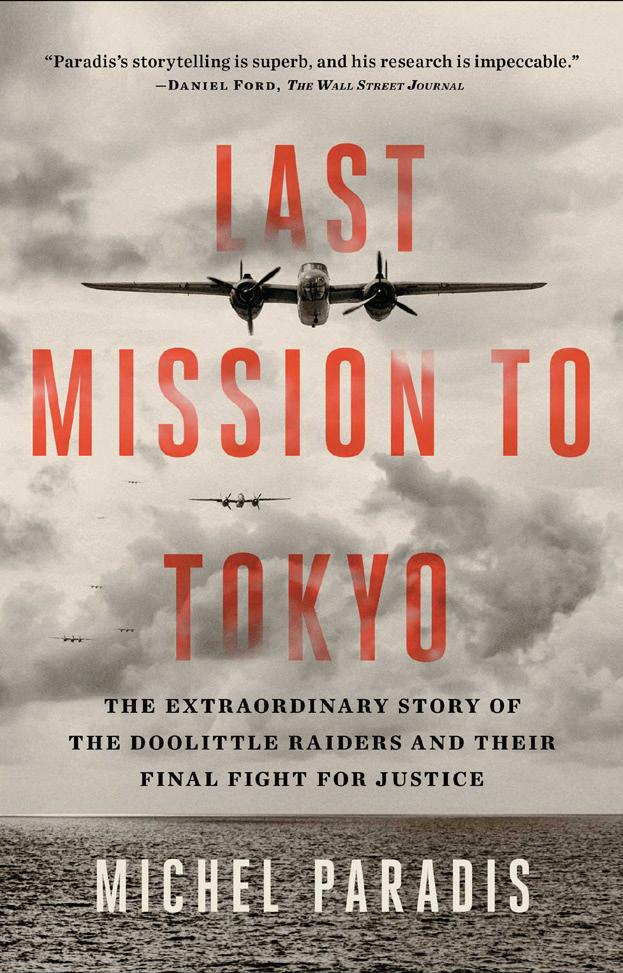
Mr. Kershaw presented the Marshall Foundation’s first in-person Legacy Lecture in two years on April 6, 2022.

TEAM AMERICA:
Patton, Macarthur, Marshall, Eisenhower, and the World They Forged by Robert L. O’Connell
Mr. O’Connell will present a Legacy Lecture on his book on October 20, 2022, at the Marshall Foundation in Lexington, Virginia.
LAST MISSION TO TOKYO:
The Extraordinary Story of the Doolittle Raiders and their Final Fight for Justice
by Michael Paradis
Mr. Paradis will present a Legacy Lecture on the Doolittle raid on August 15, 2022, at the Marshall Foundation in Lexington, Virginia.
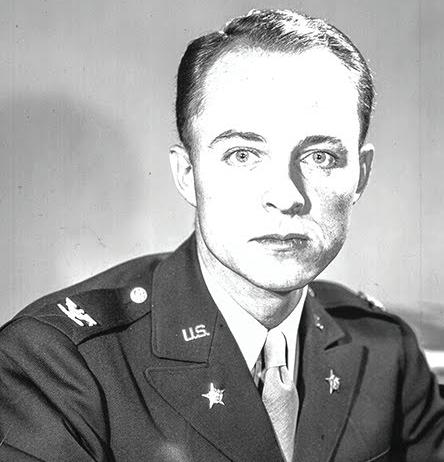
All of the Marshall Foundation’s public lectures, including Lt. Col. Jim Dittrich’s recent, popular presentation on Marshall’s aide and confidante Frank McCarthy (above), are available on www.youtube.com/c/GCMarshallFoundation
21 RECENT BOOKS AND LECTURES

THE PHYSICAL DECLINE OF MARSHALL
“A POOR SPECIMEN OF A MAN”
by Tom Bowers
George Marshall enjoyed good health for most of his nearly seventy-nine years, due mostly to healthy practices and minimizing stress. He ate wholesome foods, exercised regularly, gardened, rode horses, and fished to ease the pressures of his responsibilities. He also compartmentalized his work and personal life to reduce pressure. Marshall did have health prob-
lems, however, starting in 1948 when he was sixty-seven, culminating in his death in 1959.
Marshall had his right kidney removed in December 1948 while he was secretary of state. He tried to keep others from learning about his surgery: “No one knows this yet except [Robert] Lovett and one or two others, but, of course, once I am operated on, a statement will have to
23
MARSHALL THE MAN
Opposite: Marshall, in good health, rides horseback, 1941.
be made in the press and I will be out of action for some little time.” Katherine might interfere, he admitted: “The present battle is to keep Katherine out of the operating room and down at Leesburg.”
Six days after his operation, Marshall wrote his sister Marie that he was making “very satisfactory progress,” but it was a “rather painful process at times.” In addition to his problems, he worried about Katherine, who was “busy looking after Madame Chiang [Kai-shek] and two secretaries down at Dodona. She gets up here every other day, but the combination of Madame Chiang at one end of the line and me sick at the other is pretty hard on her. However, she always does get the short end of the deals.”
At sixty-eight years old, Marshall told a VMI classmate in January 1949 that his doctors were satisfied with his recovery from the surgery but that he was not. “This getting used to one kidney is a slow business,” Marshall complained, “and requires a great deal of patience, of which I have discovered I have only a small amount!” He told
some students in a letter that he planned to stay in office for as long as he could. He knew, however, that Katherine would have something to say about the matter. His aide, Marshall Carter, added a postscript to Marshall’s letter: “The General told me orally to tell you when you get older you will understand that the lady of the house also has an opinion in such matters.”
Katherine did have an opinion about the matter. An Associated Press photo showed a frail Marshall standing next to her in Pinehurst, and she told friends that she wanted him to be seen with a cane so that people would know that he would not be available for public appearances for a long time.
Marshall was bedridden with a persistent cough on October 30, 1953, when he learned that he had been awarded the Nobel Peace Prize. President Dwight Eisenhower arranged to have Marshall flown to Walter Reed Hospital on November 2. He thanked Eisenhower and said he was feeling better, although his coughing continued, and he had lost fifteen pounds. Four days later,

24
A seated Marshall with cane in hand following his kidney operation, 1949.
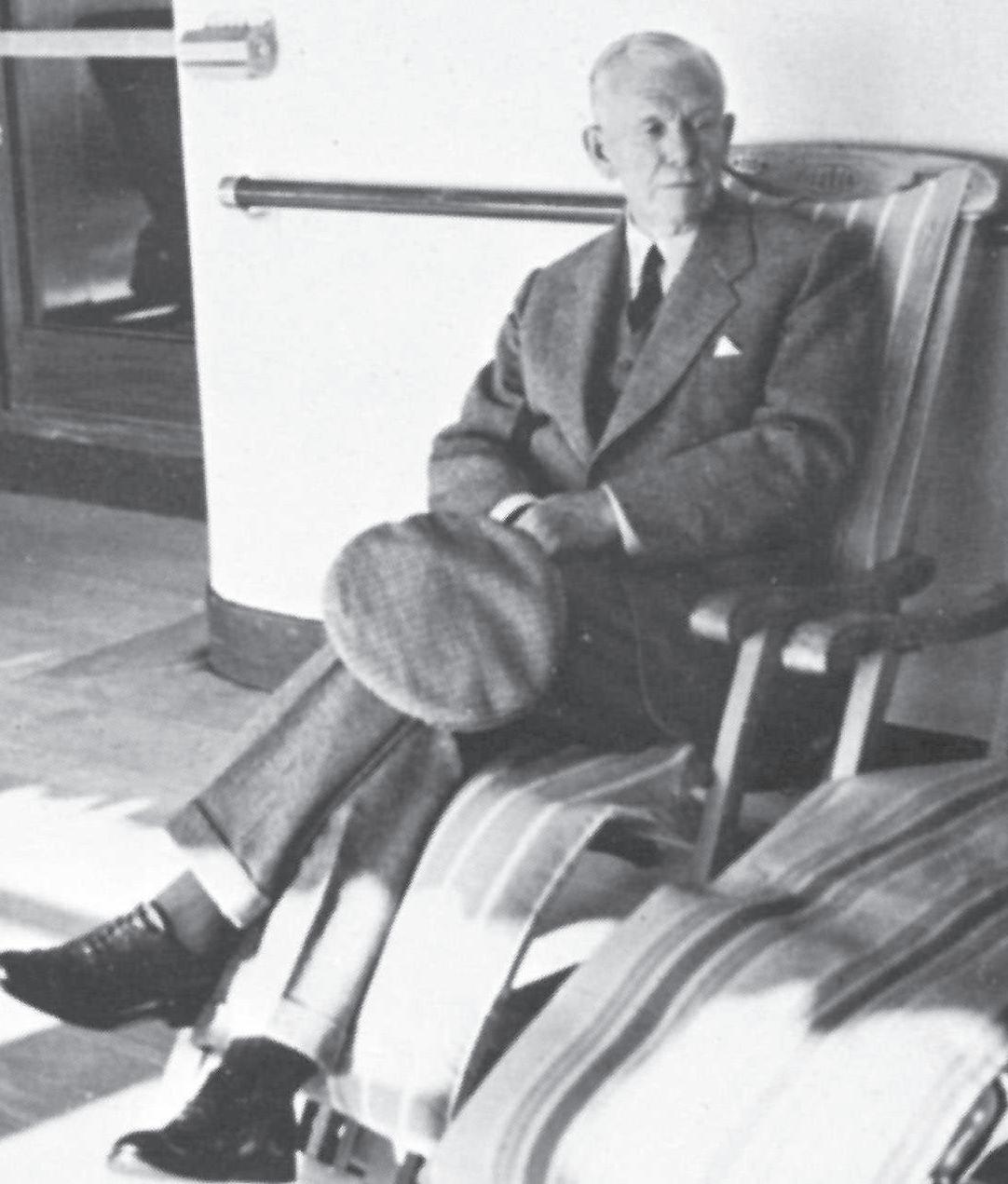
Marshall apologized for not writing to his wife: “Once I crawled into bed I have remained there without a break and not felt like writing,” he explained.
The trip to Norway for the Nobel presentation taxed an already weakened Marshall. The ceremony was scheduled for December 10 in Oslo, and Marshall was expected to make a speech the following day. The director of the Nobel Institute asked Marshall to send the title and three copies of his speech. His illness had prevented him from “giving much thought” to his lecture, Marshall replied, and he planned to write it while on the ship to Europe.
Marshall boarded the Andrea Doria on November 28 for the transatlantic voyage, accompanied by C. J. George, his aide. The trip was not as restful and productive as Marshall had hoped. He wrote Katherine while at sea, reporting that although the weather was bad he had good care. However, he was not writing: “I am having a terribly hard time getting down to the business of writing my lecture. I cant [sic] seem to concentrate.” After the ship docked at Naples, Italy, on December 6, Marshall flew to Paris, where

then-Colonel Andrew Goodpaster helped him finish the speech. Following the speech on December 11, he returned to the U.S. by plane and went straight to Pinehurst.
The respiratory ailment persisted. Seventythree-year-old Marshall told Eisenhower that he was still housebound because the “virus business is persistent.” He complained to former President Truman that the Oslo trip was “a most difficult time” because of the cold and damp ocean voyage. He expressed frustration to Admiral Richard Byrd in May 1954: “The risk in this business is that, when you feel considerably better, you immediately do some things, and then you lose a lot of ground. You have to be very lazy, very indefinite; altogether worthless, as I am now. You can’t beat the game on this thing.”
He was not back to his usual self by August. “I have been going very slowly to recoup from the damage done my heart or circulation by this persistent virus-flu,” he told Marshall Carter. “They tell me I look better than I have for years but I am still very careful.” He had maintained his weight in the 180s; his blood pressure was 190/100 and as low as 150/100 while he was in bed. Marshall
25
Marshall aboard the Andrea Doria, November, 1953.

had atrial fibrillation, but his pulse rate remained low, and his kidney function was adequate.
Robert Lovett reported in October 1954 that Marshall looked “tanned and well” and that his blood pressure had dropped from 200 to 150. “He has succeeded in keeping his weight down,” Lovett wrote, “and he is in better shape than I’ve seen him for a long time.”
Marshall told a friend in September 1955 that he had just returned from a four-day checkup at Walter Reed, which showed that the “disintegrating process had subsided” and that he was better than he had been two years earlier. He mentioned the “flu-virus” but said he was feeling “more vigorous.” His doctors had told him to avoid strenuous exercise, and his garden had suffered, he complained.
A different health problem manifested itself in February 1956 when Marshall was seventy-five. He told former aide Frank McCarthy in early February that he had been at Walter Reed for several days because of a rash [apparently shingles].
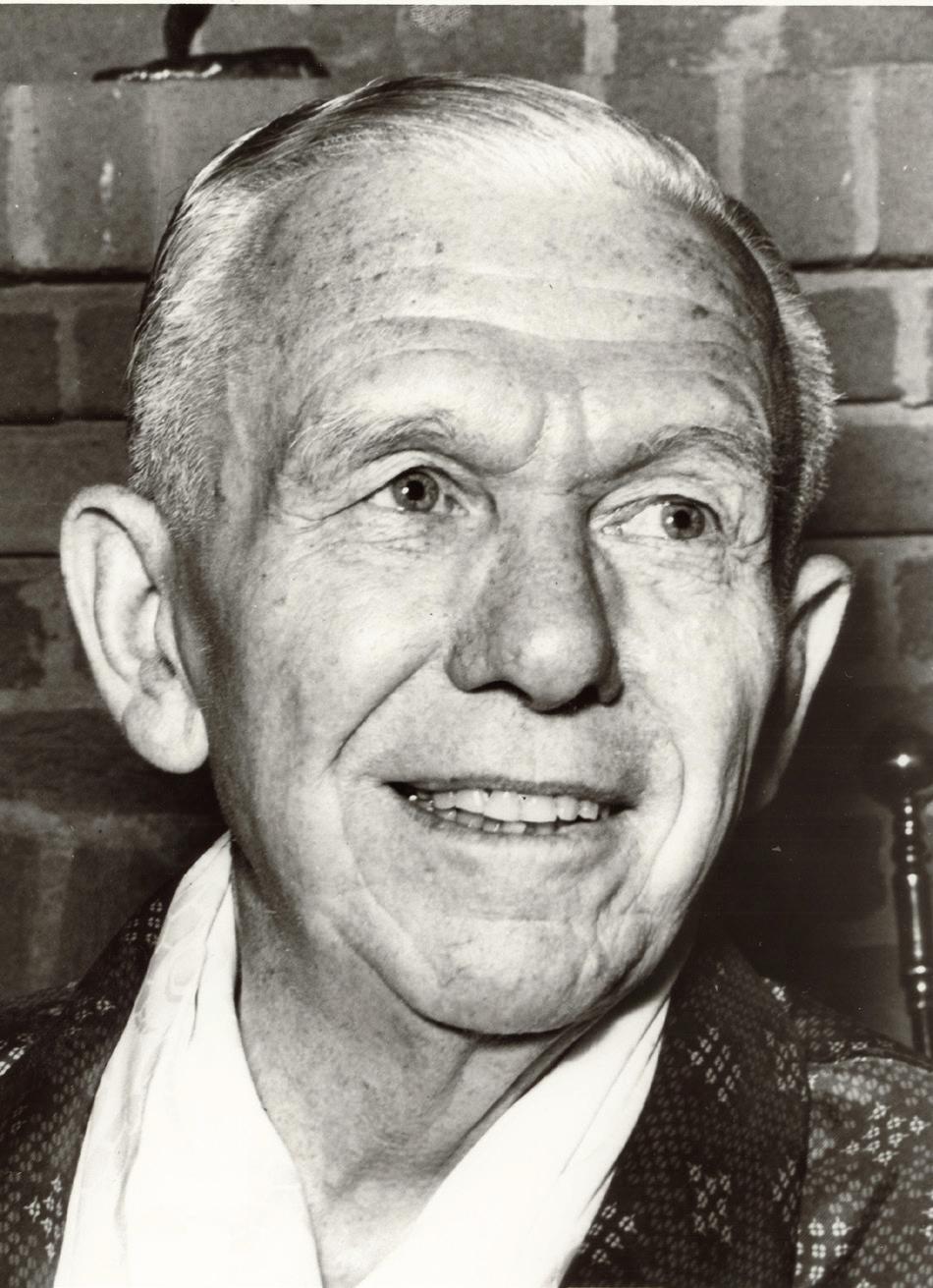
Marshall also had trouble focusing his right eye because of a ruptured vein in his head. Hearing issues appeared for the first time, also. Marshall had a 60 percent hearing deficiency in his left ear and 50 percent in the right ear. He had a hearing aid but used it only for movies and television. Marshall’s health problems were serious enough to prompt him to give C. J. George instructions about funeral arrangements—instructions that reiterated what he had told George earlier.
He admitted to a friend on December 17 that “there are a great many things about me that are failing, notably my hearing, and, I must admit, my sense of balance.” He jocularly added, “I have been told many times that I was off balance, but now I can understand it.” He told General Matthew Ridgway that he used to make fun of his mother because she carried around so many medications. “Now, by glory,” he joked, “I have as many as she had.”
Marshall’s health declined seriously in 1957 after his seventy-sixth birthday. He told a friend on
26
Marshall recuperates at Pinehurst following his illness, 1953
February 9 that he was having trouble—his hand was usually steady, but he could not write. Dictating was no problem—he had dictated thirty-two letters in one hour at Walter Reed the previous month. Marshall taped his last interview with biographer Forrest Pogue in Pinehurst on April 11. He promised Pogue that he would continue the interviews in May when he returned to Leesburg, but he never did. Katherine shared her concerns with a friend in April: “G. is very frail & seldom goes out even for a drive now.”
The Marshalls returned to Walter Reed for checkups in May 1957. General Walter Bedell Smith was in an adjoining room, but Marshall’s hearing problem prevented him from conversing with Smith. Marshall wrote Truman that his doctors found him “quite perfect, except that they can’t help me at all.” He confided to Queen Frederica of Greece that he had had a “pretty sorry winter,” and he told Madame Chiang Kai-shek that Katherine had been nursing him. His lack of appetite was causing him to lose weight, and
he suffered from a balance problem, leading him to say that he sometimes felt like he was going to “fall on my nose.”
Marshall’s condition had not improved by July 1, when he told a friend that he was “pretty-much housebound.” That led Katherine to take a drastic step—hiring a doctor from Walter Reed to come to Leesburg to give Marshall injections of Diamox, a drug for dizziness and glaucoma. He was on a low-salt diet, and his balance problems were so bad that he asked Sergeant William Heffner, his live-in orderly, to stand guard in the bathroom in case he fell while taking a shower.
C. J. George wrote in September that Marshall was “very frail, weighing only about 150 pounds.” His equilibrium was poor, and he seemed to be bored. George told Queen Frederica that Marshall had not been well for a long time, was unable to write, and had difficulty dictating. While at Walter Reed for tests in October, Marshall did not dictate a single letter, in contrast to his many letters earlier that year.
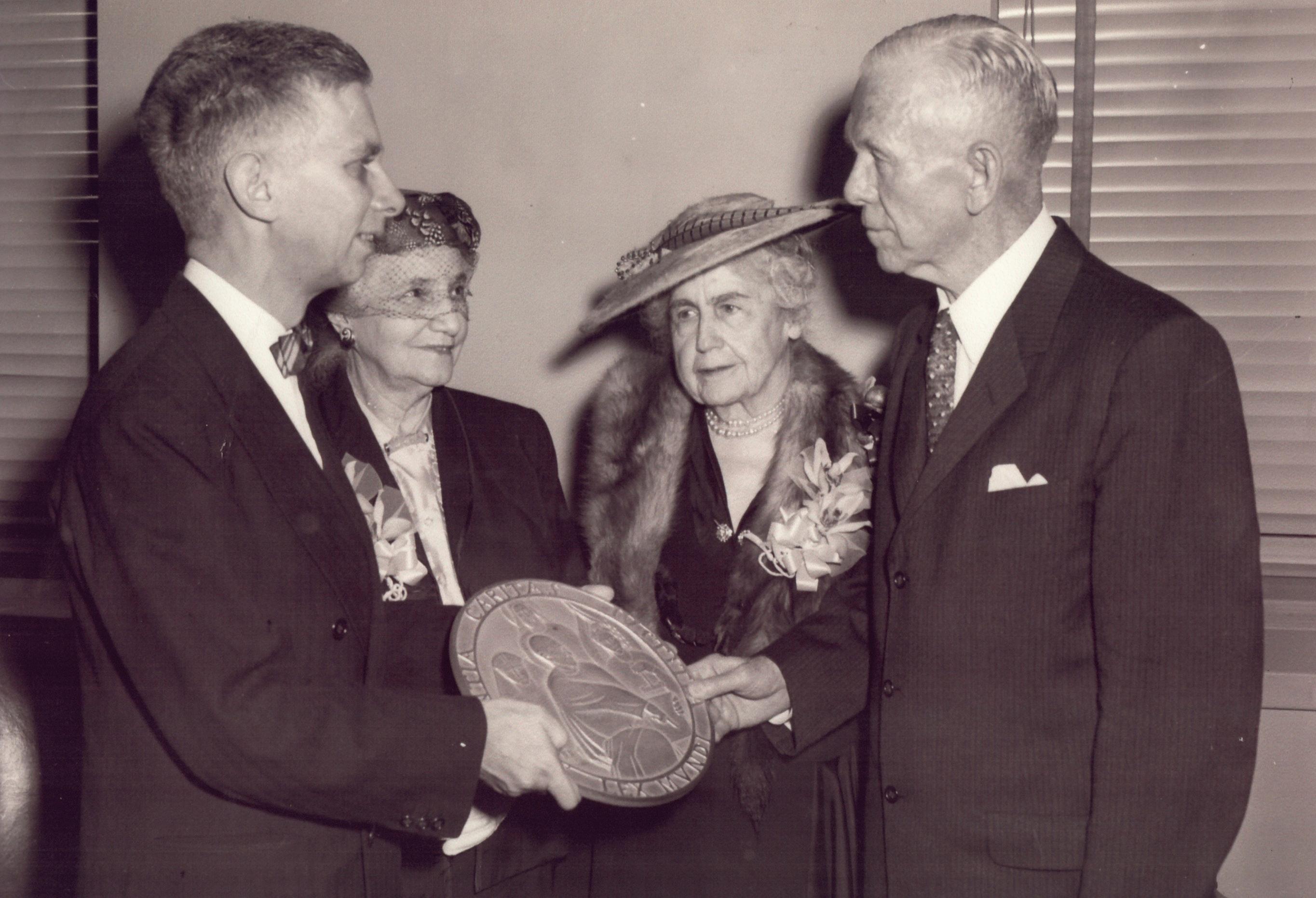
A noticeably thinner Marshall accepts Woodrow Wilson Award, October, 1956
27
Marshall was aware of his declining health but tried not to let it hamper him. Just before Christmas in 1957, he wrote a poignant handwritten note to Truman: “My dear Mr. Truman. I did not want to type a letter to you and I may not be able to complete one in longhand—but I’ll try.
Katherine is well but pretty hard worked keeping house and looking after or nursing me. I am about the same—possibly a little better off than last year—Less of unbalancing. I walk about six blocks a day—but with someone with me. In other words I am a poor specimen of a man. They tell me I look well, but I am very thin. You knew me at 200 lbs. I now weigh 150.”
His condition worsened throughout 1958. He admitted to Winston Churchill that he was “not doing quite as well” as Katherine was, but he told Queen Frederica that he was walking up to a mile a day and enjoying occasional days in Pinehurst when they could sit outside for meals and drinks. Marshall told Madame Chiang that Katherine was devoting a lot of her time to nursing him and that he was “humiliated to be failing in my duty to her.”
Marshall expressed frustration to a friend from his childhood home of Uniontown, Pennsylvania, on April 1: “I am pretty poorly off these days
and I don’t grow better with time.” He turned down an invitation to attend a reunion of the First Division, saying he was a “poor hand these days,” and “the years have a way of curtailing all desirable activity.” C. J. George told Katherine that Marshall’s color was good, his step was stronger, and his appetite was “ravenous.” His nurses said he had been eating “like a little pig.” In June, George told Carter that Marshall was eating well but had no taste for exercise. He was spending almost all day in bed, and George feared that he would become so weak that he would not be able to exercise at all.
Marshall spent three weeks at Walter Reed in August for the removal of a cyst and a hair follicle in his left eye. His balance problem persisted, and he fell and broke a rib. His appetite had returned, he told President Eisenhower, and he had gained eight pounds. C. J. George told Lovett that Marshall’s condition varied day by day: “One day he will be quite cheerful, bright and lucid, and the next day, the complete opposite.” Carter told Lovett that Marshall was “incoherent and demoralized” at Marshall’s condition: “I had not seen him for almost 9 months and while I had anticipated some degradation in his physical condition, I thought I detected a degree of faltering
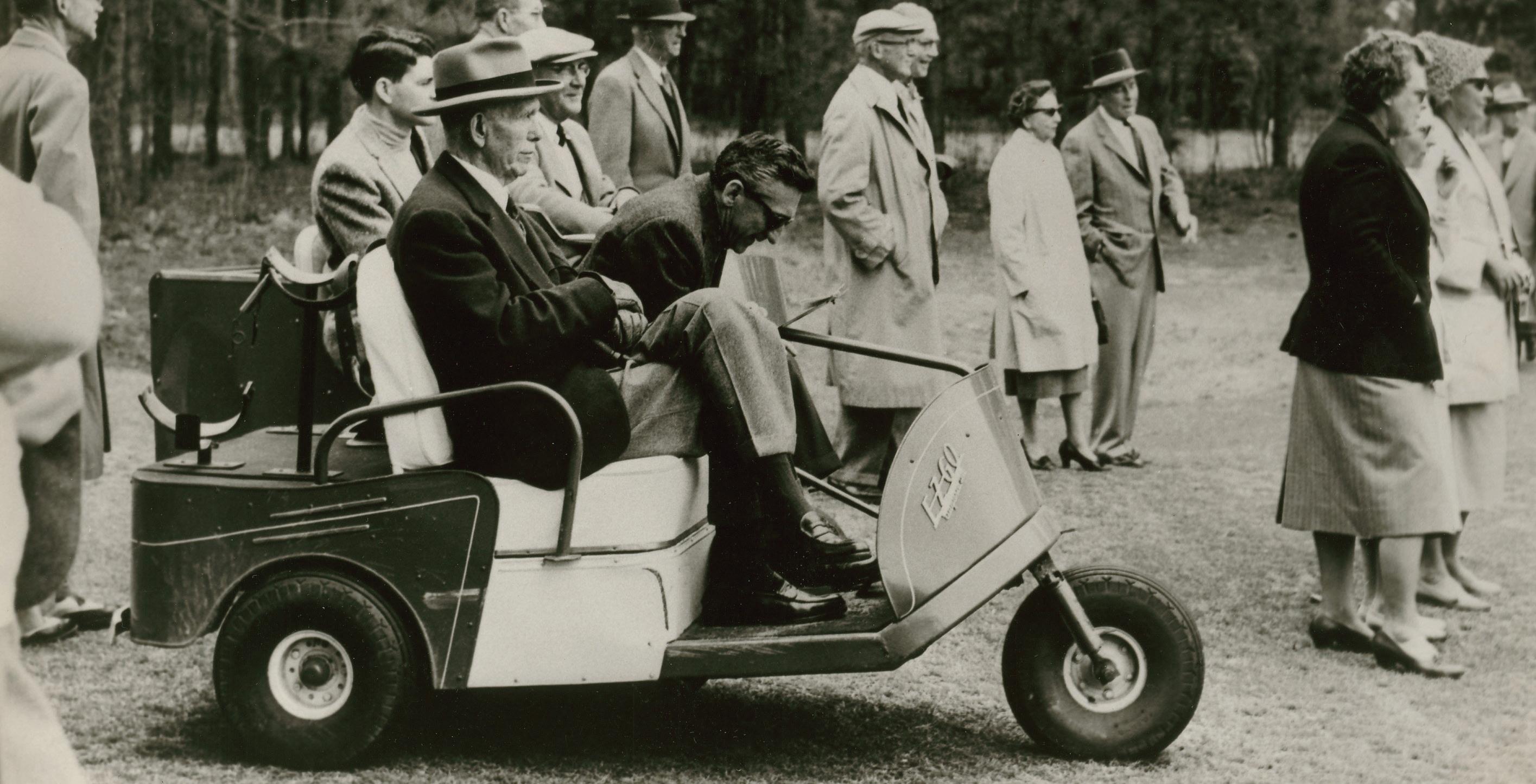
28
Marshall at Pinehurst, 1959

in his mental processes that I had never before experienced.”
“While the Old Man was feeble,” Lovett wrote after a visit, “he still seemed to me to be cheerful and eager, and that is really what counts in this case.” He said Marshall’s friends should not visit him because it would be too tiring for him.
C. J. George said in August 1958 that General Thomas Mattingly, chief of medicine at Walter Reed, had recommended that a medical attendant be posted at Marshall’s home in Leesburg because of the danger of his falling. George forwarded that recommendation to Katherine, who said such an arrangement “would not be practicable.” She said that she had converted their powder room in Dodona Manor to a bedroom for Marshall and that she and Heffner were almost constantly caring for their patient. When Marshall returned to Dodona on August 23, Katherine told a friend that his injections and medication had weakened him greatly. He had insisted
on coming home, she said, but he was “really a hospital case.” Marshall was seldom out of bed, she confided, but he was happier at Dodona than anyplace else, and she wanted to keep him out of the hospital.
Katherine hired a male nurse from the Leesburg hospital to care for Marshall from 3 to 11 p.m. daily. Lovett told Carter on September 16 that “There is no question that his machinery is wearing out.” He thought that Marshall would be better off at Walter Reed but he did not know how anyone could make such an “offensive” suggestion. Marshall was taken from Leesburg to Walter Reed on September 23, and plans were made to transfer him from there to Fort Bragg instead of back to Leesburg, meaning that September 23, 1958, was Marshall’s last day at Dodona Manor. He told Queen Frederica in November that she should not visit him because she would find him “a poor conversationalist.”
Rose Wilson, Marshall’s goddaughter, noticed
29
Cartoon by Bill Mauldin commemorating Marshall’s death, 1959
Opposite: George C. Marshall
lying in state at the National Cathedral, Washington, D.C., 1959
how frail he had become. He said that he was not going to get well but that Katherine did not want to believe it. He asked Rose to tell Katherine that he was going to die soon and that she needed to make plans. A distressed Rose could not talk to Katherine about such matters, and she spoke instead to Katherine’s daughter Molly, but she would not accept reality, either.
Marshall wrote Henry Cabot Lodge, Jr., on October 18 that he was “not stepping very high.” After a thorough examination, doctors told him that all his vital signs were good, leading Marshall to conclude that “it is all a matter of age.” It was the last letter that bears Marshall’s signature. Katherine told a friend that the cottage in Pinehurst was being “run as a small hospital.” Queen Frederica cheered him with a visit there on October 25.
The seventy-eight-year-old Marshall suffered a stroke in Pinehurst, on January 16, 1959, and he was taken to the army hospital at nearby Fort Bragg, where doctors concluded that he had suffered no paralysis. They thought he would be in the hospital for six weeks, and Katherine stayed in a room across the hall. When Rose Wilson saw him after his stroke, he had to ask her where he was, and it was the last time he spoke to her.
The doctors had been overly optimistic, however, and Marshall suffered a second stroke on February 17, leading Katherine to convey bad news to Frank McCarthy: “He is desperately ill,” she said, adding that his eyes and throat were affected, and he could not speak or see. By February 24, C. J. George reported that Marshall’s condition had stabilized and that he was awake and alert. Marshall was transferred from Fort Bragg to Walter Reed by aircraft and ambulance on March
11, and President Eisenhower visited him on March 13. Katherine moved into an apartment on the hospital grounds. C. J. George told Marshall’s sister on March 24 that her brother was making “slow progress,” sitting up, and seemed “bright and cheerful.”
George told a family friend on April 10 that Marshall was “beginning to enjoy visitors.” He also told Marshall’s sister that his vision was still poor, he could not read, and he was listening to recordings for the blind. President Eisenhower and Winston Churchill visited Marshall on May 5, but it was not one of his good days, causing Churchill to weep openly in the hospital room. Several people visited Marshall: General Maxwell Taylor, General Lawton Collins, General Harold Bull, Anna Rosenberg, and Vice President Richard Nixon. Lovett visited every two weeks, and he sometimes took Marshall outside to enjoy the sunshine.
More bad news came on June 18, when George reported that Marshall had “slipped somewhat” and was “unusually frail and weak.” George later told Ridgway that he was amazed at Marshall’s alertness on some days, “but then he slips into twilight.” Marshall’s weight had dropped to 136 pounds. Hospital officials wanted to put Marshall in what was called General Pershing’s suite, but Marshall was alert enough to refuse because he considered that room a shrine.
George Marshall died at 6:08 p.m. on October 16, 1959, of a “cerebrovascular accident due to hypertension.” He was ten weeks short of his seventy-ninth birthday. He was buried at Arlington National Cemetery on October 20.
Tom Bowers is former docent director of George Marshall’s Dodona Manor in Leesburg, Virginia. From 1971 to 2006, he was professor and dean of the School of Journalism and Mass Communication at the University of North Carolina at Chapel Hill. His article, “A Tonic to My Spirit: George Marshall and the American Red Cross,” appeared in the Summer 2020 issue of this magazine.
30

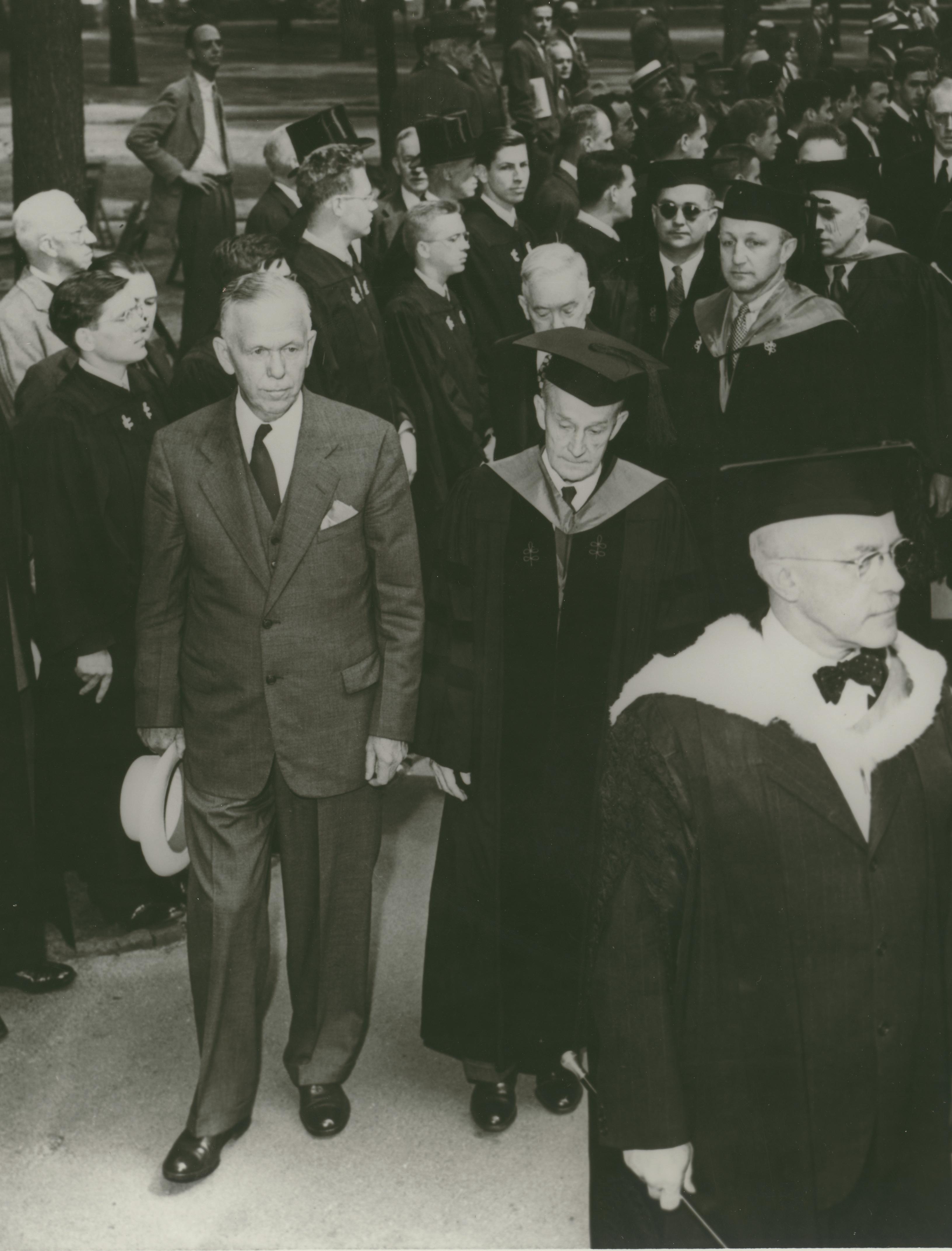
THE SPEECH THAT CHANGED THE WORLD
MARSHALL’S ADDRESS AT HARVARD, 1947
When Secretary of State George C. Marshall accepted an invitation from Harvard University to receive an honorary degree during the first week in June 1947, the State Department informed the president of the Alumni Association that Marshall would make a speech for the afternoon meeting of the Harvard Alumni Association but that he did not want it to be the major speech of the occasion. There were no discussions with representatives of
other governments; there were no notifications of the American press that an important speech was to be delivered, and even Harvard President James B. Conant did not expect a major address from Secretary Marshall.
The speech was drafted by Chip Bohlen, a Russia specialist and interpreter who used memoranda from the Director of the Policy Planning Staff George F. Kennan and from Under Secretary of State for Economic Affairs William Clay-
Opposite: Marshall participates in the procession at Harvard University, June 5, 1947. (Harvard Libraries photo.)
33
THE MARSHALL PLAN AT 75
ton. Bohlen especially benefited from Clayton’s graphic oral descriptions of Europe’s situation. In a memorandum he wrote, “Millions of people in the cities are slowly starving,” and if the standard of living continued to deteriorate, “there will be revolution.”
On the day of the speech the capacity crowd of 15,000 in Harvard Yard did not expect to see history made but simply to see one of the most admired public servants in America. However when Secretary Marshall began to read his speech there was a recognition that the carefully worded
remarks on the political and economic crisis in Europe were of great importance. In that speech, Marshall outlined the need for an economic aid plan to help the devastated nations of Europe and their citizens to recover from the ravages of World War II. The secretary of state committed the United States to consider a European recovery plan that would be developed by the Europeans and presented to the United States. Thus was launched the Marshall Plan, for which George C. Marshall would be awarded the Nobel Peace Prize.

34
President Truman signs the European Recovery Act, commonly known as the Marshall Plan

THE SPEECH
Mr. President, Dr. Conant, members of the board of overseers, ladies and gentlemen, I’m profoundly grateful and touched by the distinction and honor and great compliment accorded me by the authorities of Harvard this morning. I’m overwhelmed, as a matter of fact, and I’m rather fearful of my inability to maintain such a high rating as you’ve been generous enough to accord to me. In these historic and lovely surroundings, this perfect day, and this very wonderful assembly, it is a tremendously impressive thing to an
individual in my position.
I need not tell you gentlemen that the world situation is very serious. That must be apparent to all intelligent people. I think one difficulty is that the problem is one of such enormous complexity that the very mass of facts presented to the public by press and radio make it exceedingly difficult for the man in the street to reach a clear appraisement of the situation. Furthermore, the people of this country are distant from the troubled areas of the earth and it is hard for them to comprehend the plight and consequent reactions of the
35
Protest in Austria, 1947

long-suffering peoples, and the effect of those reactions on their governments in connection with our efforts to promote peace in the world.
In considering the requirements for the rehabilitation of Europe the physical loss of life, the visible destruction of cities, factories, mines and railroads was correctly estimated, but it has become obvious during recent months that this visible destruction was probably less serious than the dislocation of the entire fabric of European economy. For the past ten years conditions have been highly abnormal. The feverish preparation for war and the more feverish maintenance of the war effort engulfed all aspects of national economies. Machinery has fallen into disrepair or is entirely obsolete. Under the arbitrary and destructive Nazi rule, virtually every possible enterprise was geared into the German war machine. Long-standing commercial ties, private institutions, banks, insurance companies and shipping companies disappeared, through loss of capital,
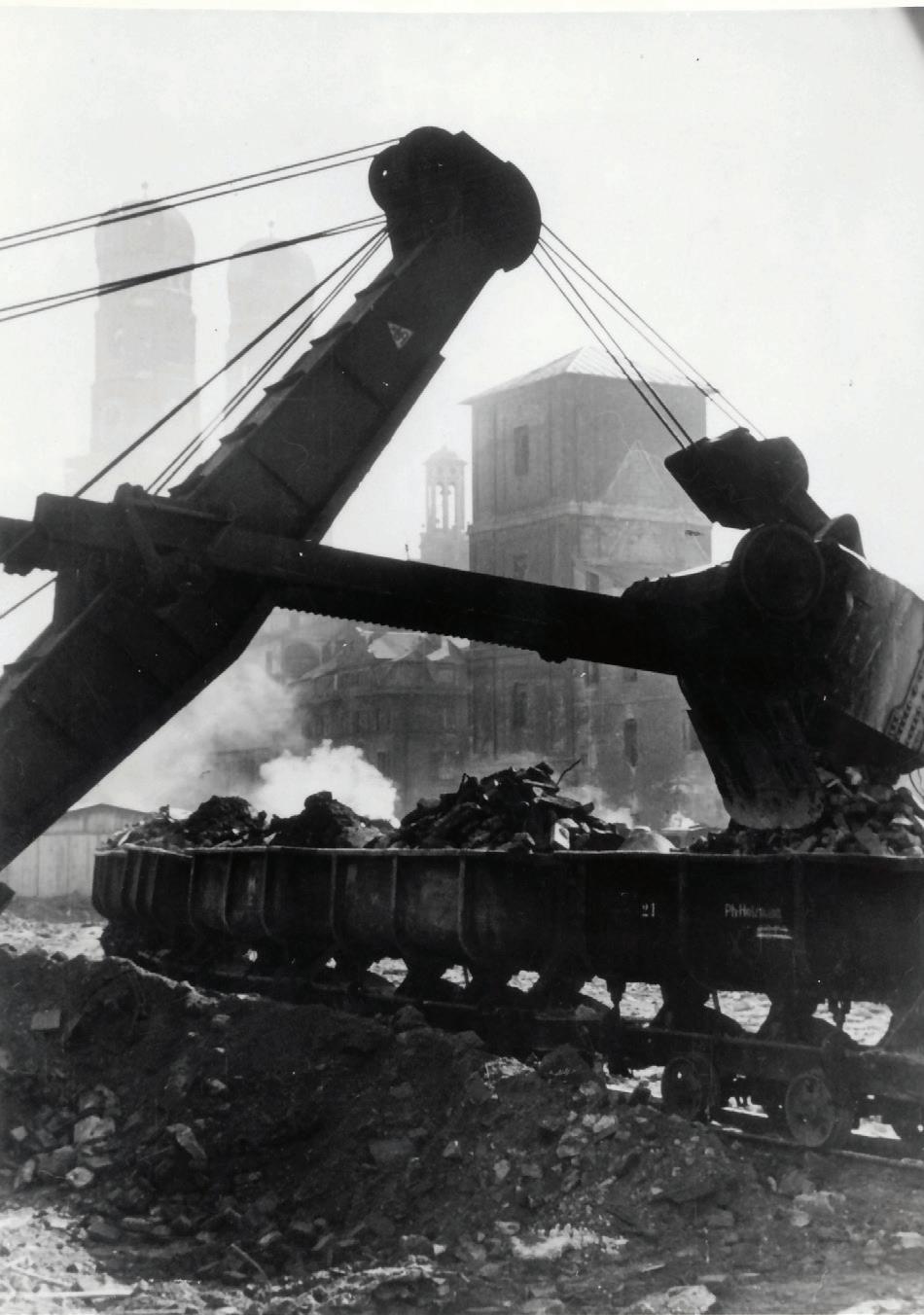
absorption through nationalization or by simple destruction. In many countries, confidence in the local currency has been severely shaken. The breakdown of the business structure of Europe during the war was complete. Recovery has been seriously retarded by the fact that two years after the close of hostilities a peace settlement with Germany and Austria has not been agreed upon. But even given a more prompt solution of these difficult problems, the rehabilitation of the economic structure of Europe quite evidently will require a much longer time and greater effort than had been foreseen.
There is a phase of this matter which is both interesting and serious. The farmer has always produced the foodstuffs to exchange with the city dweller for the other necessities of life. This division of labor is the basis of modern civilization. At the present time it is threatened with breakdown. The town and city industries are not producing adequate goods to exchange with the
36
Left: Ruins of the Brandenberg Gate, Berlin, following World War II
Right: Clearing debris in Munich

food-producing farmer. Raw materials and fuel are in short supply. Machinery is lacking or worn out. The farmer or the peasant cannot find the goods for sale which he desires to purchase. So the sale of his farm produce for money which he cannot use seems to him an unprofitable transaction. He, therefore, has withdrawn many fields from crop cultivation and is using them for grazing. He feeds more grain to stock and finds for himself and his family an ample supply of food, however short he may be on clothing and the other ordinary gadgets of civilization. Meanwhile people in the cities are short of food and fuel. So the governments are forced to use their foreign money and credits to procure these necessities abroad. This process exhausts funds which are urgently needed for reconstruction. Thus a very serious situation is rapidly developing which bodes no good for the world. The modern system of the division of labor upon which the exchange of products is based is in danger of breaking down.

The truth of the matter is that Europe’s requirements for the next three or four years of foreign food and other essential products–principally from America–are so much greater than her present ability to pay that she must have substantial additional help, or face economic, social and political deterioration of a very grave character.
The remedy lies in breaking the vicious circle and restoring the confidence of the European people in the economic future of their own countries and of Europe as a whole. The manufacturer and the farmer throughout wide areas must be able and willing to exchange their products for currencies the continuing value of which is not open to question.
Aside from the demoralizing effect on the world at large and the possibilities of disturbances arising as a result of the desperation of the people concerned, the consequences to the economy of the United States should be apparent to all. It is logical that the United States should do whatever
37
Left: A farmer in Austria Right: Unloading shipment of fertilizer with ERA shield, Netherlands
it is able to do to assist in the return of normal economic health in the world, without which there can be no political stability and no assured peace. Our policy is directed not against any country or doctrine but against hunger, poverty, desperation and chaos. Its purpose should be the revival of a working economy in the world so as to permit the emergence of political and social conditions in which free institutions can exist. Such assistance, I am convinced, must not be on a piece-meal basis as various crises develop. Any assistance that this Government may render in the future should provide a cure rather than a mere palliative. Any government that is willing to assist in the task of recovery will find full cooperation, I am sure, on the part of the United States Government. Any government which maneuvers to block the recovery of other countries cannot expect help from us. Furthermore, governments, political parties or groups which seek to perpetuate human misery in order to profit therefrom politically or otherwise will encounter the oppo-
sition of the United States.
It is already evident that, before the United States Government can proceed much further in its efforts to alleviate the situation and help start the European world on its way to recovery, there must be some agreement among the countries of Europe as to the requirements of the situation and the part those countries themselves will take in order to give proper effect to whatever action might be undertaken by this Government. It would be neither fitting nor efficacious for this Government to undertake to draw up unilaterally a program designed to place Europe on its feet economically. This is the business of the Europeans. The initiative, I think, must come from Europe. The role of this country should consist of friendly aid in the drafting of a European program and of later support of such a program so far as it may be practical for us to do so. The program should be a joint one, agreed to by a number, if not all European nations.
An essential part of any successful action on the Left:
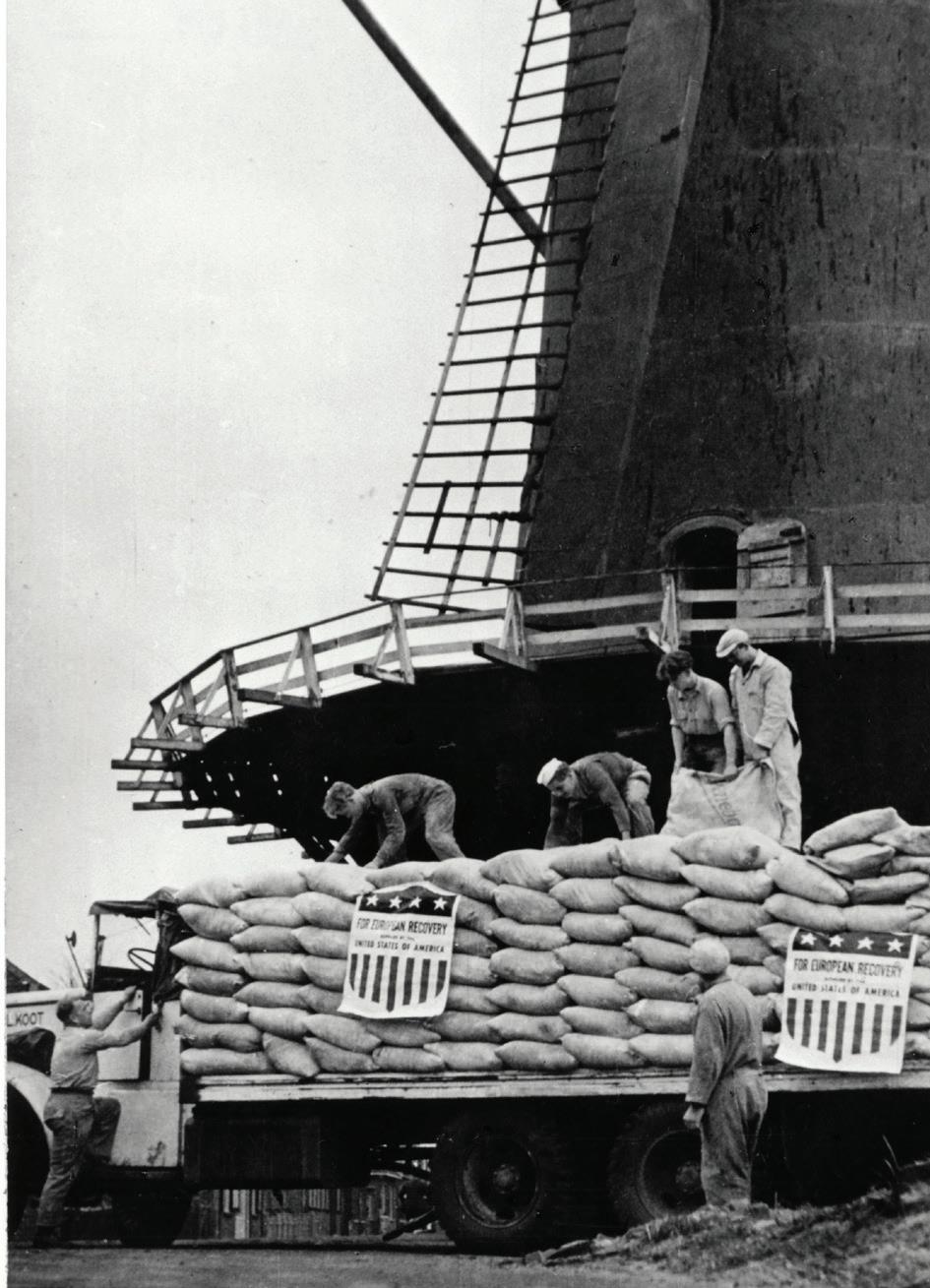
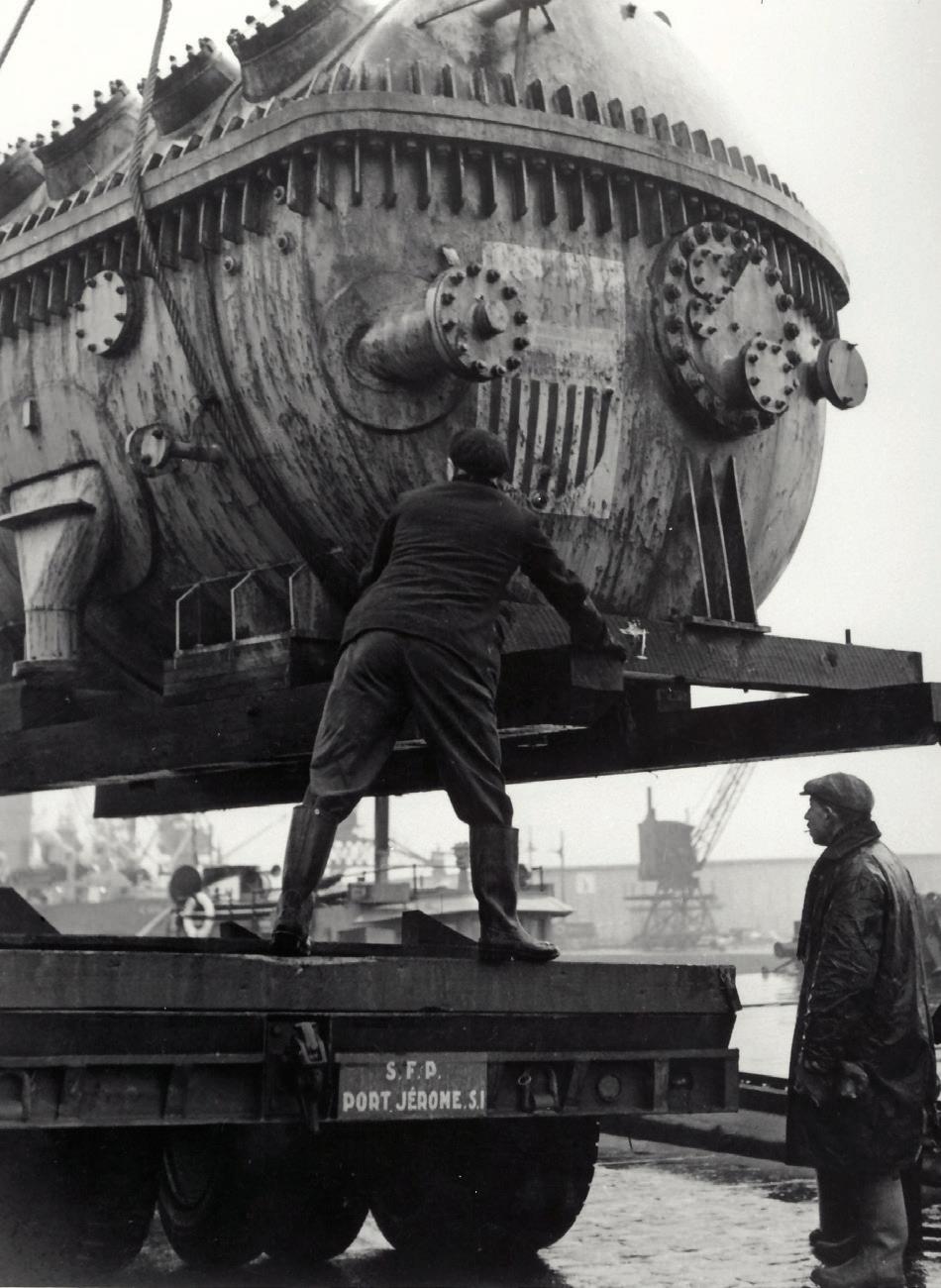
38
ERA grain is delivered to a windmill, Netherlands
Right: Unloading a tank bearing ERA shield at refinery, France
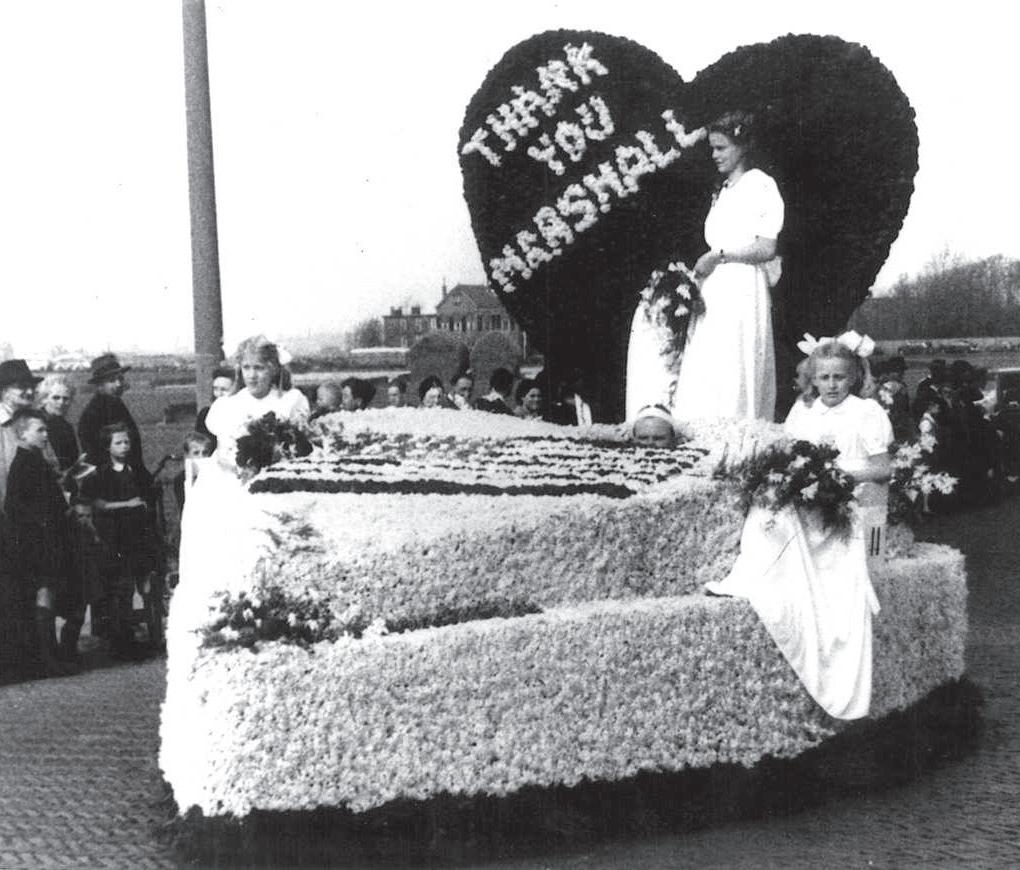
part of the United States is an understanding on the part of the people of America of the character of the problem and the remedies to be applied. Political passion and prejudice should have no part. With foresight, and a willingness on the part of our people to face up to the vast responsibility which history has clearly placed upon our country, the difficulties I have outlined can and will be overcome.
I am sorry that on occasion I have said something publicly in regard to our international situation; I’ve been forced by the necessities of the case to enter into rather technical discussions. But to my mind, it is of vast importance that our people reach some general understanding of what the complications really are, rather than react from a
passion or a prejudice or an emotion of the moment. As I said more formally a moment ago, we are remote from the scene of these troubles. It is virtually impossible at this distance merely by reading, or listening, or even seeing photographs or motion pictures, to grasp at all the real significance of the situation. And yet the whole world of the future hangs on a proper judgment. It hangs, I think, to a large extent on the realization of the American people, of just what are the various dominant factors. What are the reactions of the people? What are the justifications of those reactions? What are the sufferings? What is needed? What can best be done? What must be done? Thank you very much.
Learn more about the impact of the Marshall Plan speech and listen to a recording at www.marshallfoundation.org/the-marshallplan/
39
A parade float in the Netherlands honors
Marshall and the ERA

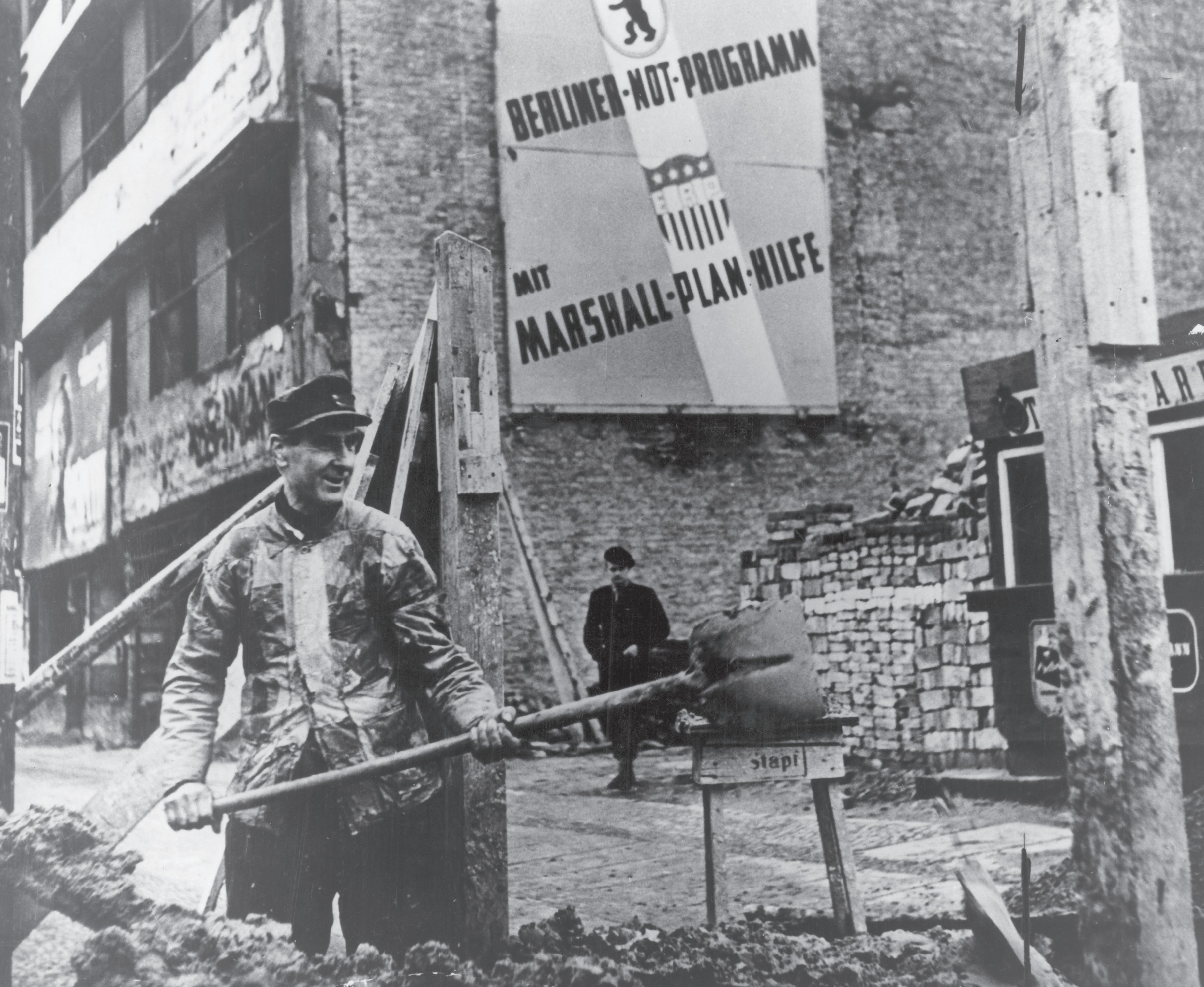
P.O. Box 1600, Lexington, VA 24450
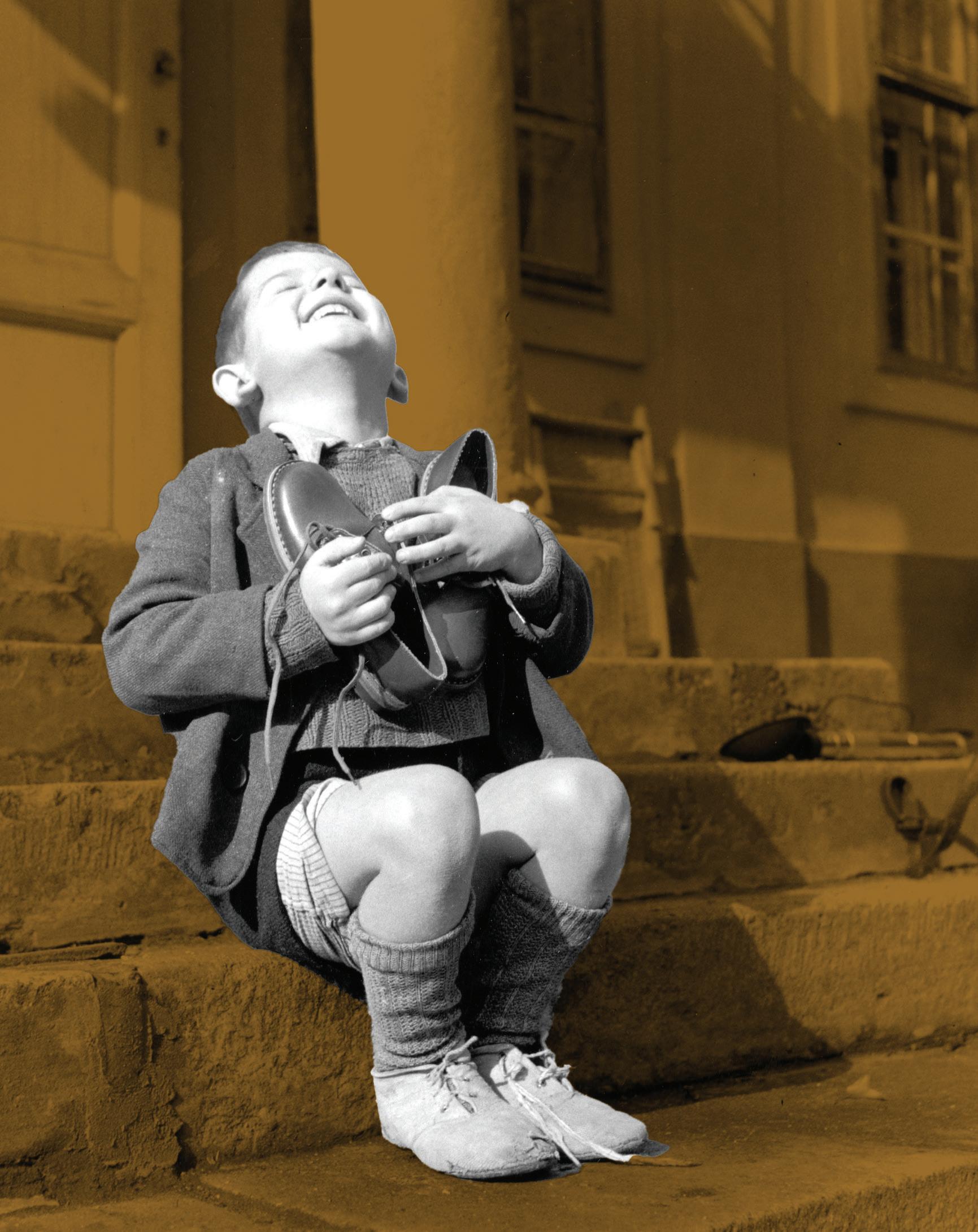

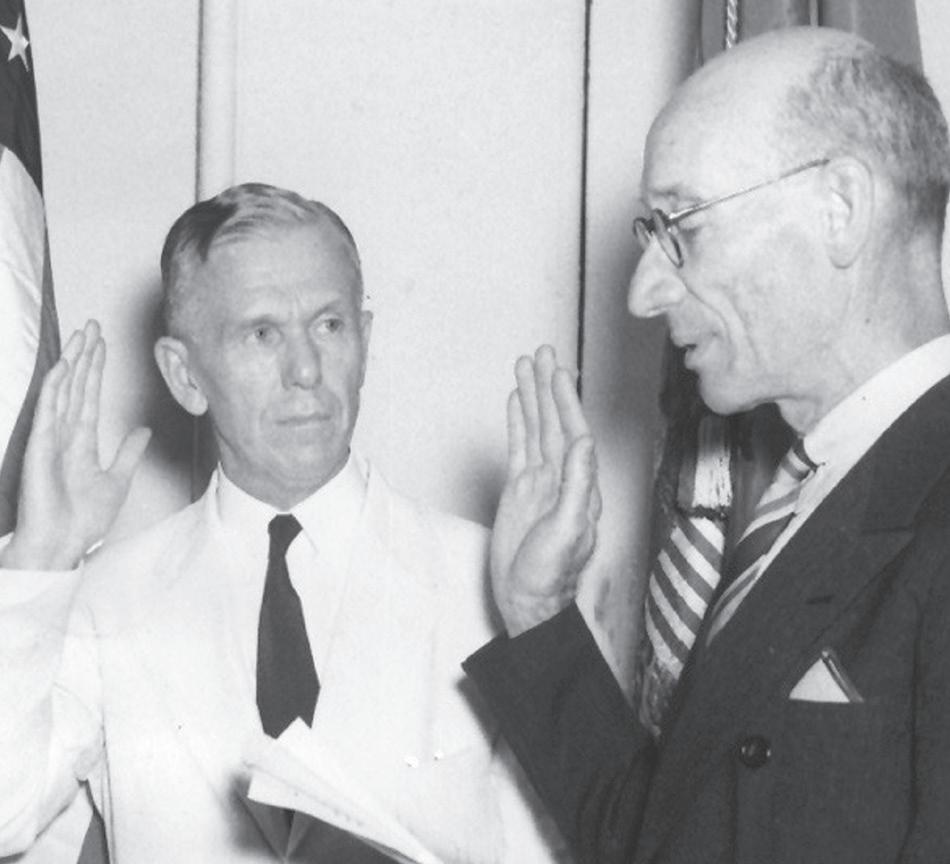
 Paul A. Levengood, President
Paul A. Levengood, President















































